- Discovery Platform
- Innovation Scouting
- Startup Scouting
- Technology Scouting
- Tech Supplier Scouting
- Startup Program
- Trend Intelligence
- Business Intelligence
- All Industries
- Industry 4.0
- Manufacturing
- Case Studies
- Research & Development
- Corporate Strategy
- Corporate Innovation
- Open Innovation
- New Business Development
- Product Development
- Agriculture
- Construction
- Sustainability
- All Startups
- Circularity
- All Innovation
- Business Trends
- Emerging Tech
- Innovation Intelligence
- New Companies
- Scouting Trends
- Startup Programs
- Supplier Scouting
- Tech Scouting
- Top AI Tools
- Trend Tracking
- All Reports [PDF]
- Circular Economy
- Engineering
- Oil & Gas


Share this:
- Click to share on Facebook (Opens in new window)
- Click to share on Twitter (Opens in new window)
- Click to share on LinkedIn (Opens in new window)
Top 9 Travel Trends & Innovations in 2024
How are the latest trends in the travel industry reshaping trip planning and enhancing tourist experiences in 2024? Explore our in-depth industry research on the top 9 travel trends based on our analysis of 3500+ companies worldwide. These trends include AI, immersive tourism, IoT, contactless travel & more!
Technological advancements in the travel industry meet the growing demand for personalized experiences, safety, and sustainability. Post the COVID-19 pandemic, emerging travel trends mark a shift towards contactless travel through digital payments, self-check-ins, and more. Additionally, artificial intelligence (AI), the Internet of Things (IoT), and blockchain are automating various hospitality and travel-related operations.
For instance, smart hotels make use of internet-connected devices to remotely control rooms. Further, businesses offer virtual tours by adopting extended reality (XR) technologies like virtual reality (VR) and augmented reality (AR). Travel companies also leverage data analytics to personalize marketing. At the same time, traveler assisting solutions like chatbots and voice technology aid them in booking accommodation and optimizing journeys. These travel trends improve the overall profitability of the tourism industry and enable it to make operations more sustainable and safe.
This article was published in July 2022 and updated in February 2024.
Innovation Map outlines the Top 9 Travel Trends & 18 Promising Startups
For this in-depth research on the Top 9 Trends & Startups, we analyzed a sample of 18 global startups and scaleups. The result of this research is data-driven innovation intelligence that improves strategic decision-making by giving you an overview of emerging technologies & startups in the travel industry. These insights are derived by working with our Big Data & Artificial Intelligence-powered StartUs Insights Discovery Platform , covering 2 500 000+ startups & scaleups globally. As the world’s largest resource for data on emerging companies, the SaaS platform enables you to identify relevant startups, emerging technologies & future industry trends quickly & exhaustively.
In the Innovation Map below, you get an overview of the Top 9 Travel Trends & Innovations that impact travel & tourism companies worldwide. Moreover, the Travel Innovation Map reveals 3 500+ hand-picked startups, all working on emerging technologies that advance their field.
Top 9 Travel Trends
- Artificial Intelligence
- Immersive Tourism
- Internet of Things
- Contactless Travel
- Big Data & Analytics
- Post-Pandemic Tourism
- Tour Premiumization
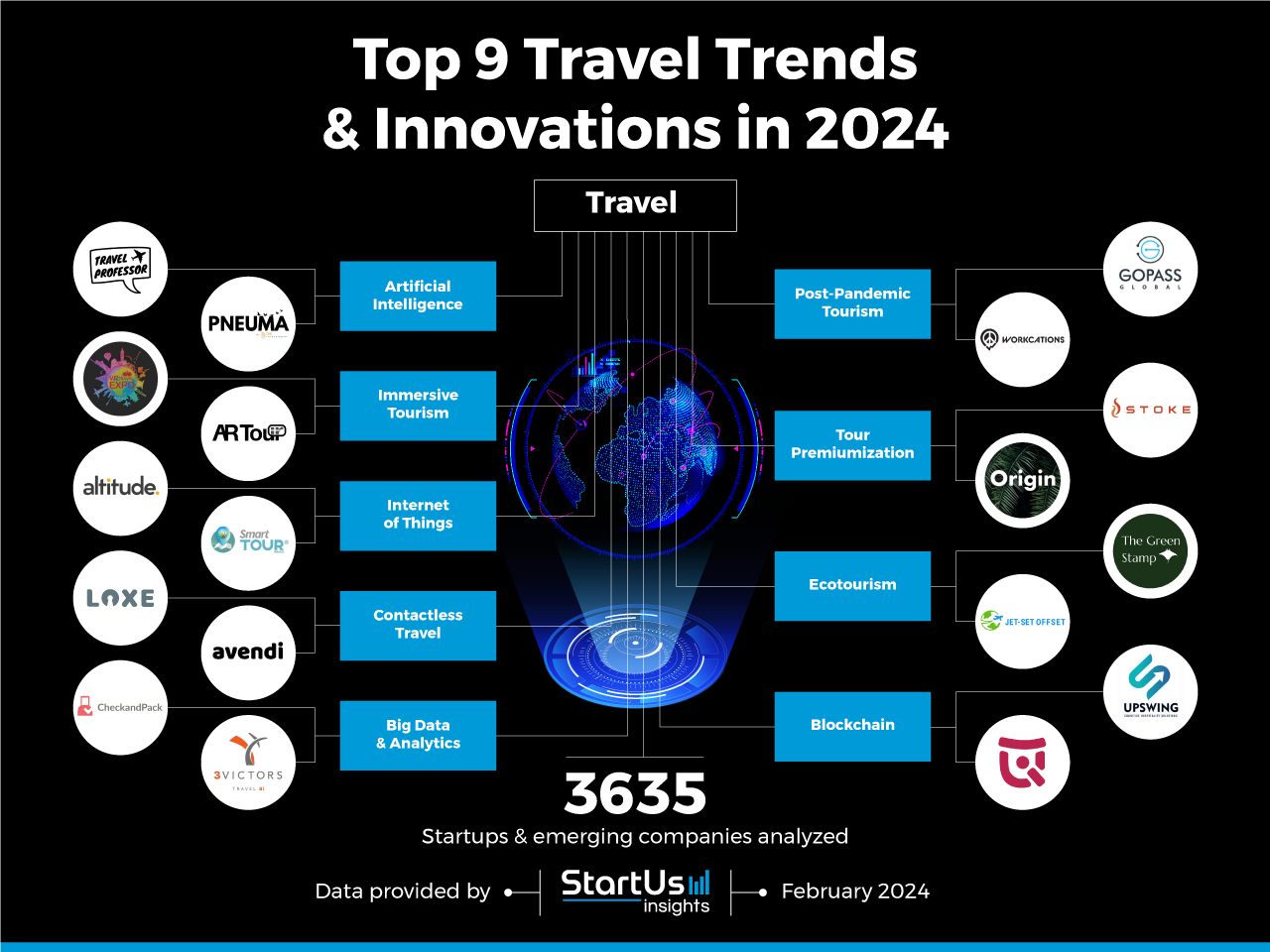
Click to download
Tree Map reveals the Impact of the Top 9 Travel Trends
Based on the Travel Innovation Map, the Tree Map below illustrates the impact of the Top 9 Travel Industry Trends in 2024. Startups and scaleups are enabling contactless travel using technologies like biometrics, radio-frequency identification (RFID), and near-field communication (NFC). This is due to increasing health and hygiene concerns post the pandemic. The use of AI in tourism ensures hassle-free trip planning while AR and VR allow tourists to virtually visit various locations and excursions. IoT increases visibility into tourism industry operations and allows passengers to track their luggage more efficiently. Further, the demand for personalized and luxurious travel is rising. Several startups enable recreational space travel as well as offer sustainable travel options to passengers.
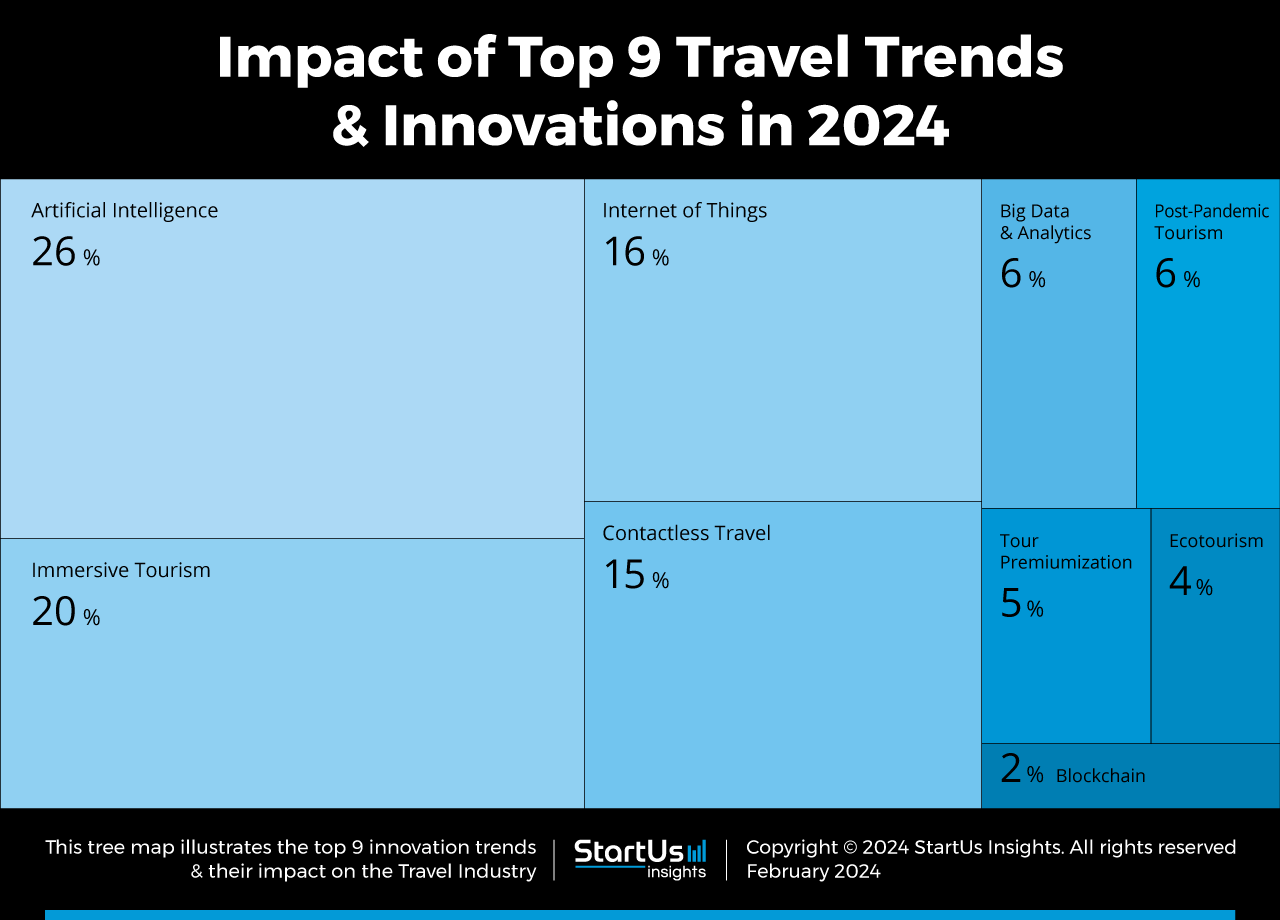
Global Startup Heat Map covers 3 635 Travel Startups & Scaleups
The Global Startup Heat Map below highlights the global distribution of the 3 635 exemplary startups & scaleups that we analyzed for this research. Created through the StartUs Insights Discovery Platform, the Heat Map reveals that the US, Europe, and India see the most activity.
Below, you get to meet 18 out of these 3 635 promising startups & scaleups as well as the solutions they develop. These 18 startups are hand-picked based on criteria such as founding year, location, funding raised, and more. Depending on your specific needs, your top picks might look entirely different.
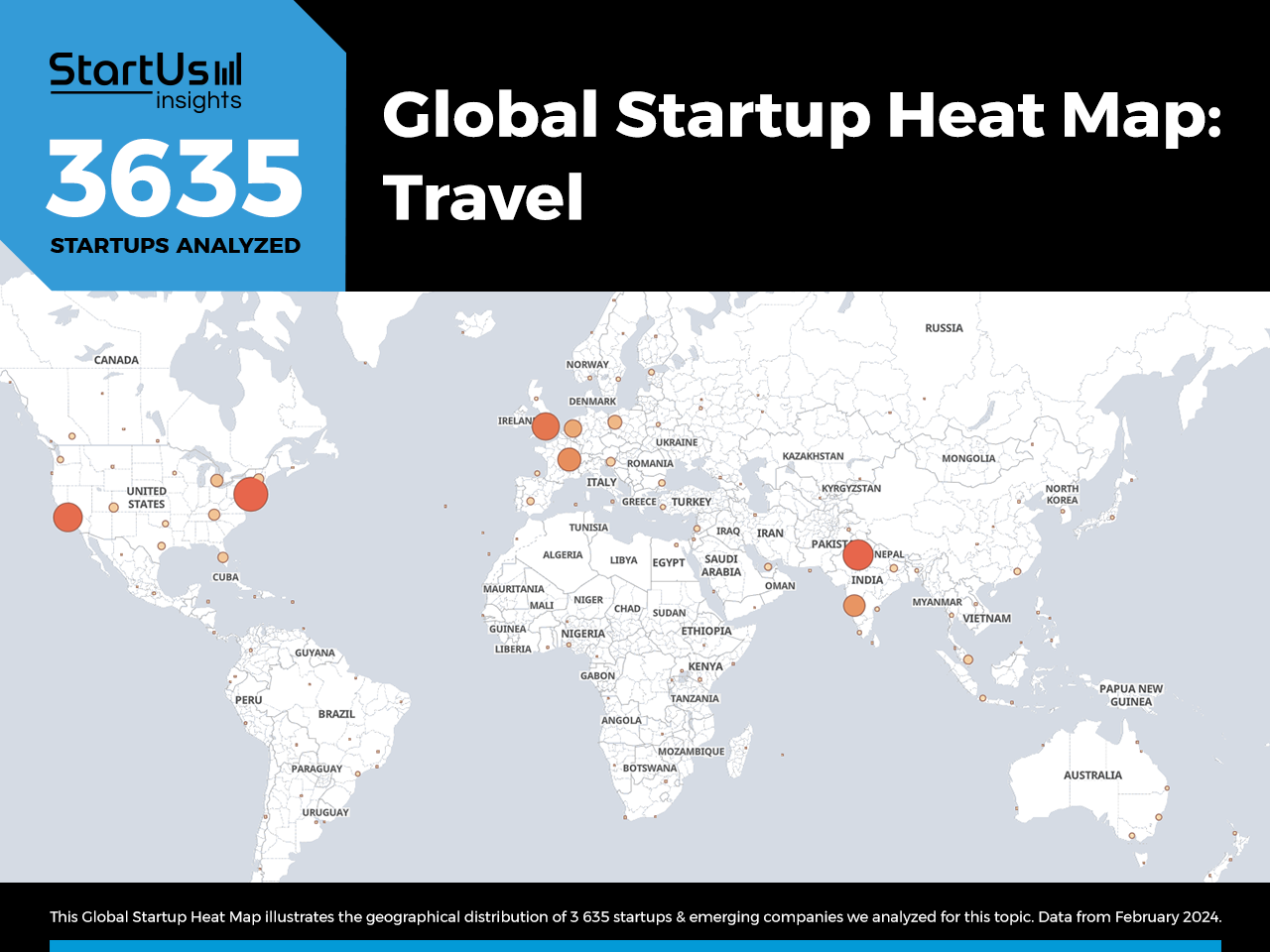
Interested in exploring all 3500+ travel startups & scaleups?
Top 9 Travel Trends in 2024
1. artificial intelligence.
Hotels employ intelligent chatbots, powered by AI, to provide quick and personalized responses to traveler inquiries. These chatbots simplify the booking process and gather customer reviews, aiding potential travelers in making informed decisions. Moreover, AI-based robots enhance the customer experience by automating hotel disinfection and delivering room service.
At airports, these robots guide travelers and assist with luggage handling. Facial recognition technology, driven by AI, expedites identity verification at airports, enhancing security and offering a swift alternative to traditional methods. Startups are developing AI-powered trip planning solutions, optimizing journeys, and personalizing travel experiences.
Travel Professor develops a Travel Chatbot
UK-based startup Travel Professor offers an AI-enabled chatbot for travelers. The startup’s chat widget software monitors multiple flight deals and notifies users when their preferences match. It also provides travel destination recommendations and flight price alerts. This allows travelers to book economical flights and have a budget-friendly tourism experience.
Pneuma Travel facilitates Travel Planning
US startup Pneuma Travel develops a voice-assisted digital agent, Sarah , to streamline the process of travel planning. This assistant, powered by AI, excels in arranging flight and accommodation bookings and assists travelers in discovering a variety of activities. Sarah , available round the clock, provides continuous support for all travel-related inquiries.
Moreover, Sarah customizes travel options according to individual preferences and budgetary constraints. The agent further enhances the travel experience by providing insights into local attractions in unfamiliar cities. Importantly, Sarah enables real-time modifications to travel plans, in compliance with specific airline policies, thereby minimizing waiting times for users.
2. Immersive Tourism
Immersive tourism caters to the growing demand for meaningful experiences among travelers, leveraging AR, VR, and mixed reality (MR). VR simulates original locations through a computer-generated environment, allowing tourists to virtually explore destinations. It provides travelers with a comprehensive 360-degree tour of points of interest.
AR enhances the travel experience with interactive elements such as navigation maps and ads. Travel companies employ AR and VR-based gamification to heighten tourist attractions. Moreover, these technologies enable hotels and resorts to present amenities and rooms in an engaging, interactive manner.
VR Travel Expo offers VR-based Travel Plans
US startup VR Travel Expo develops a VR travel application to transform the way people research and book travel. The application enables users to plan their vacations more efficiently. It provides an engaging platform for users to explore and expand their knowledge of the world. Moreover, it employs 3D geospatial technology that creates real-time digital twins of the world. This further enhances the travel planning experience.
AR Tour makes AR Glasses
Italian startup AR Tour offers AR-powered tours. The startup’s AR glasses superimpose reconstructed images of archaeological ruins to show how the site originally was. Its tour informs the tourists about the site’s history and significance via an audio-visual package. Moreover, the startup designs lightweight AR glasses to prevent motion sickness among tourists, improving convenience.
3. Internet of Things
IoT generates ample data that tourism companies leverage to personalize services in their subsequent visits. Hotels use IoT sensors to enable smart rooms that automate room lighting, temperature, and ambiance control, enhancing guest comfort. These sensors adjust appliances in vacant rooms, conserving energy and reducing the building’s carbon footprint.
Startups harness IoT to deliver location-specific information to customers, including real-time luggage tracking via IoT tags, minimizing lost items. Airlines also incorporate IoT-based solutions into seats, monitoring passenger temperature and heart rate for proactive health management.
Altitude enables Smart Hotels
New Zealand-based startup Altitude creates an IoT-based hotel software and hardware to develop smart hotels. The startup makes self-service kiosks to automate reservations, room up-gradation, payments, as well as check-in and check-out. Its hotel management platform further enables contactless engagement with guests. Additionally, Altitude’s mobile keys allow guests to open doors using mobile phones, providing convenience and saving time for travelers.
Smart Tour provides Smart Itineraries
Brazilian startup Smart Tour offers smart itineraries using IoT and quick response (QR) codes. The startup recommends travel routes and destinations based on the user’s preference in real-time. This facilitates a seamless experience for travelers. Besides, the user-generated data enables tourism managers to better understand consumer behavior and indulge in proximity marketing. The startup also offers a contact tracing solution to monitor COVID-19 infected travelers and ensure public safety.
4. Contactless Travel
Travelers benefit from contactless recognition technologies like retina scanning, which replace traditional travel documents, speeding up passenger identification and reducing airport queues. QR codes offered by travel companies allow tourists to access relevant information on their mobile devices, enhancing engagement.
Hotels have introduced contactless self-check-ins, enabling visitors to arrange services before arrival. Additionally, contactless payment modes are available in hotels and restaurants for swift and secure transactions. Moreover, wearable devices are transforming the travel experience by providing real-time notifications and touch-free access to services and information.
Loxe designs Smart Hotel Keys
US-based startup Loxe makes smart mobile keys for hotels. The startup’s smartphone app replaces key cards with contactless mobile keys that allow users to unlock doors using smartphones. It also reduces operational costs incurred in the manufacturing of conventional keys or plastic cards. Moreover, the startup designs a Bluetooth retrofit module that converts normal door locks into mobile-ready door locks. This allows hotel owners to easily convert their existing locks into smart ones without additional expenses while improving guest safety and convenience.
Avendi provides Contactless Payment
Singaporean startup Avendi offers contactless and cashless payments for travelers. The startup allows tourists to accumulate expenses throughout their trip and pay at the end of the journey. Avendi’s app utilizes QR codes to add all the billed expenses and shown through its dashboard. The user settles the tab amount in the preferred currency, preventing the inconvenience of cash withdrawal or credit card payments.
5. Big Data & Analytics
Big data empowers travel companies with customer trends for strategic marketing. Analyzing traveler behavior, they offer tailored recommendations for hotel bookings, cab hires, flight reservations, and ticket purchases.
Predicting future demand is another advantage of big data and analytics, helping hotels and airlines identify peak periods to optimize revenue. Advanced analysis of transactional data aids in detecting cyber fraud, and safeguarding sensitive customer information such as credit card details and biometric data.
CheckandPack creates a Travel Platform
Dutch startup CheckandPack offers a big data travel platform. It runs marketing campaigns to gather traveler data and understand tourism trends. Based on these insights, the platform enables businesses to approach travelers with a customized appeal. It also provides travelers with holiday planning.
3Victors provides Travel Data Analytics
US-based startup 3Victors offers travel data analytics. The startup’s product, PriceEye Suite , proactively monitors the prices of numerous airlines to provide insights into competitor prices. It creates a dashboard to display travelers’ location of interest, allowing travel airlines to better manage their revenue and pricing strategy.

6. Post-Pandemic Tourism
Post-pandemic tourism focuses on safe, sustainable, and flexible travel options, responding to evolving traveler preferences and health guidelines. Enhanced health and safety protocols, including regular sanitization and contactless services, become standard in airlines and hotels, ensuring traveler confidence.
Destinations and operators emphasize outdoor and less crowded experiences, catering to a heightened demand for nature-based and wellness travel. Flexible booking policies and trip insurance gain prominence, offering peace of mind amid uncertainties. Sustainable travel gains traction, with tourists and businesses prioritizing environmental impact and community well-being.
GOPASS Global enables Pre-travel Risk Management
Singaporean startup GOPASS Global provides a travel risk analytics platform against COVID-19. It analyzes the biosecurity risk elements involved in a trip, such as border restrictions, quarantine requirements, airport type, and airline transit points or seating in real-time. This allows travelers to assess risk factors and plan their trips accordingly.
Moreover, the startup creates world maps displaying information regarding COVID-prone areas, testing areas, and vaccine coverage. This provides travelers with a preview of the current situation, allowing them to ensure safety during business and leisure travel.
Workcations enables Work from Anywhere
Indian startup Workcations provides properties at tourist destinations for remote-working individuals. It offers amenities like internet connectivity, food, and a quiet ambiance, allowing tourists to work in a peaceful environment without hindrance. This increases employee productivity, motivation, and retention.
7. Tour Premiumization
Hyper-personalization in travel experiences is on the rise, with tourists eager to immerse themselves in diverse cultures. Luxury travelers enjoy tailored experiences and intuitive services through tour premiumization. Health and wellness packages offered by travel startups help tourists unwind.
These retreats enhance health and offer detoxifying food options. Space tourism is another exciting development, offering leisure or research trips to space. Lastly, travel startups are fostering customer loyalty and building strong relationships through membership or subscription models.
STOKE provides Space Tour
US-based startup STOKE facilitates space travel using everyday-operable rockets. The startup’s rockets are reusable and deliver satellites to any desired orbit. This enables on-demand access to space, paving way for space tours for exploration, recreation, and research. The startup also emphasizes the economical and rapid development of its hardware for feasible spacecraft launches, advancing space tourism.
Origin offers Travel Personalization
Dutch startup Origin provides premium travel personalization to tourists. The startup utilizes machine learning and travel curators to plan creative vacations. It also arranges flights and accommodation for travelers. Further, the startup measures the carbon output of itineraries and offers sustainable tourism options.
8. Ecotourism
Traveling responsibly minimizes tourism’s environmental impact and supports local communities’ well-being. Ecotourists strive to reduce their carbon footprint during their journeys. Startups contribute by developing sustainable transport, ecolodges, and solar-powered resorts.
Airline passengers have the option to offset carbon emissions during flight bookings. Local tourism stimulates small businesses economically and creates job opportunities. It also emphasizes minimum littering, which lowers pollution and the time spent on cleanups.
Jet-Set Offset simplifies Flight Carbon Offset
US-based startup Jet-Set Offset creates a carbon-offsetting platform for air travel. The startup partners with non-profit organizations working against climate change and connects them with travelers. Each time travelers book flight tickets via the startup’s platform, Jet-Set Offset contributes a certain amount per mile for their journey to environmental organizations. This way, the passenger’s journey promotes mileage-based donations to offset carbon emissions.
The Green Stamp facilitates Ethical Wildlife Tour
Dutch startup The Green Stamp provides a platform to book ethical wildlife tours. It curates tours based on the tourists’ inclinations toward certain locations or wildlife. Exploration of these projects allows travelers to indirectly contribute to their cause as these wildlife projects donate to the welfare of local communities and the environment.
9. Blockchain
Blockchain provides the travel industry with operational transparency and security. Traceable payments, particularly for international travel, are a key application, that fosters trust among parties involved in transactions.
Automation and enforcement of agreements in travel insurance and supplier contracts are achieved through smart contracts. This strengthens reliability and cuts administrative costs. Travel firms establish customer loyalty programs where points are exchanged for cryptocurrency. Lastly, blockchain increases data storage security, reducing the risk of information leaks.
Upswing facilitates Guest Profiling
Indian startup Upswing creates AURA , a blockchain-powered platform for guest profiling. It provides a holistic view of guests, their preferences, and purchase patterns. The platform associates a score with each guest and suggests improvements in their service. This facilitates hotels to provide a personalized experience to their guests and, in turn, increase sales.
UIQ Travel develops a Solo Traveling App
US-based startup UIQ Travel develops a blockchain-based app to connect solo travelers. It discovers people with shared interests and suggests tours or attractions. Such hyper-personalized recommendations assist in experience discovery and also increase traveler engagement.
Discover all Travel Trends, Technologies & Startups
Tourism, although severely impacted by the pandemic, now continues to rapidly grow across the globe. Post-pandemic trends indicate an increasing emphasis on hygiene and safety during travel. The industry is witnessing the widespread adoption of disruptive technologies like AI, XR, IoT, and blockchain. The travel industry utilizes big data to understand traveler trends for targeted marketing. The transition to ecotourism is accelerating as businesses integrate zero-emission transit and carbon offset programs to reduce their carbon footprint.
The Travel Trends & Startups outlined in this report only scratch the surface of trends that we identified during our data-driven innovation and startup scouting process. Among others, personalization, decarbonization, and travel safety will transform the sector as we know it today. Identifying new opportunities and emerging technologies to implement into your business goes a long way in gaining a competitive advantage. Get in touch to easily and exhaustively scout startups, technologies & trends that matter to you!
Your Name Business Email Company
Get our free newsletter on technology and startups.
Protected by reCAPTCHA and the Google Privacy Policy and Terms of Service apply.
Discover our Free Travel Report
Book a call today!

Mobility 22 pages report
Railway 22 pages report, cleantech 19 pages report.
Leverage our unparalleled data advantage to quickly and easily find hidden gems among 4.7M+ startups, scaleups. Access the world's most comprehensive innovation intelligence and stay ahead with AI-powered precision.
Get in touch
Your Name Business Email Company How can we support you? (optional)
Business Email

Protected by reCAPTCHA and the Google Privacy Policy and Terms of Service apply.
National Geographic content straight to your inbox—sign up for our popular newsletters here

5 pandemic tech innovations that will change travel forever
These digital innovations will make your next trip safer and more efficient. But will they invade your privacy?
In the 20 months since the COVID-19 pandemic began, technological innovations have gone from futuristic to familiar. These days it’s hard to be out in the world without encountering QR-coded menus or supplying digital vaccine passports.
As the tourism industry—which logged a billion fewer international arrivals in 2020 than 2019—sputters back to life, masks may begin to disappear, but many pandemic-era tech tools will continue to factor into your trips.
“Consumers will come to expect technologies that make them more confident about travel,” says Steve Shur, the president of the Travel Technology Association. “Some of these changes are here to stay.”
In fact, a 2021 Pew Research survey of 915 policy leaders, science researchers, and other experts predicts that, by 2025, our daily lives could be even more influenced by algorithms, remote work, and what some call “tele-everything.”
While novel interventions such as real-time translation devices and facial recognition passport control may make travel safer and more efficient, there are downsides, including concerns about privacy , data security, and biased technology. Here are some of the innovations that travelers will continue to see and use.
Virtual and augmented reality
When the pandemic shut down travel, museums and tourist destinations turned to augmented reality (AR) and virtual reality (VR) to create online exhibits and experiences. While some of these experiences are best seen with a VR headset, most can be enjoyed with just a computer or smartphone.
The Xplore Petra app launched in June 2020, allowing users to “visit” Jordan ’s most iconic archaeological site by projecting a scaled-down version of the ruins. Lights over Lapland, an Arctic travel company, launched a VR experience to show off the Northern Lights using VR headsets or computer screens.
( How virtual reality might change your next trip, even after COVID-19. )
Post-pandemic, VR and AR may enhance actual trips by adding experiences such as a simulated climb up the Matterhorn at Lucerne’s Swiss Museum of Transport . The Hunt Museum in Limerick, Ireland, has a VR attraction in which visitors immerse themselves in “ The Garden of Earthly Delights ,” a 500-year-old painting by Hieronymus Bosch.
The Museum of Natural History in Paris has an AR exhibit that brings visitors face to face with extinct animals in digital form. The National Museum of Singapore has an installation called “Story of the Forest,” where sightseers explore a virtual landscape comprised of almost 70 nature drawings from the museum collection. The Smithsonian Institution’s National Museum of Natural History , in Washington, D.C., has an app that uses AR to show what some of its animal skeletons would look like with skin and muscle over the bones, offering a new view of a collection dating back to the 1880s.
“VR is not going to replace travel and tourism. It is just going to enhance tourism,” says Anu Pillai, who runs the Digital Center of Excellence at Wipro, a technology company.
Crowd control
To help enforce social distancing, cities, airports, and museums tested or rolled out crowd-control technology including Singapore’s roaming, vaguely terrifying robots that announce people are too close together and signs indicating how large crowds are at airport gates . As throngs of travelers return to popular destinations, similar methods and devices may be implemented to prevent overtourism.

In Italy during the pandemic, Venice began tracking visitors using cameras designed to catch criminals. Post-pandemic, it plans to harness them to keep tourist numbers at manageable levels, perhaps in concert with the mayor’s proposal to add electronic gates at major entry points (cruise ship docks, train stations) that can be closed if the city gets overcrowded.
(These tech changes could make your next flight safer.)
“We know minute by minute how many people are passing and where they are going,” Simone Venturini, Venice’s top tourism official, told the New York Times . “We have total control of the city.”
Amsterdam , which also struggles with overtourism, tracks how visitors use Amsterdam’s City Card, a flat-fee pass to museums and public transport. Beach Check UK launched this summer with real-time information on how busy dozens of beaches are along the English coast, guiding travelers away from packed areas.
“Technology can be used to collect data in order to both make better decisions and communicate those decisions,” says Christopher Imbsen, director of sustainability at World Travel & Tourism Council.
UV-C cleaning
Hospitals have used UV-C light to disinfect and kill viruses for more than two decades. Now, indoor public spaces including airports, gyms, and movie theaters are adding UV-C to halt viral spread.
“UV-C is having its heyday right now,” says Peter Veloz, CEO of UltraViolet Devices, which makes UV disinfecting technology.

UV-C has germicidal properties that combat COVID-19 and other nasties, both in the air or on surfaces. Depending on the location, new UV-C installations go into HVACs, on escalator handrails, or through airports and planes via light-equipped robots that disinfect as they go.
If installed and operated correctly, a UV-C system can kill all sorts of bacteria and germs. Even seasonal flu bugs might be zapped before they spread. “COVID-19 could come and go, but what won't disappear are normal pathogens,” Veloz says.
QR codes at restaurants
In the early days of the pandemic, when transmission of the COVID-19 wasn’t yet well understood, restaurants hurried to provide QR codes. The little black boxes of pixelated dots and dashes could be scanned with a smart phone to bring up a menu, let you order from it, and then allow you to pay your bill, all with limited virus-spreading interactions with servers.
While earlier fears that people could catch the virus via menus and other surfaces have been disproven, the codes have proven convenient and will probably stick around, especially with late-pandemic worker shortages.
Such convenience might mean a trade off with privacy, however, since the little codes can potentially gather a large amount of information from users. Some QR programs just take a food order, but others mine data like a patron’s dining history, age, and gender. The restaurant could use that info to send them coupons or event invitations—or sell it to third parties.
“It’s an example of companies exploiting COVID-19 to extend tracking,” says Jay Stanley, a senior policy analyst at the ACLU. “Moving everything to mobile opens people to new ways of tracking and control.”
Travelers should know that QR codes can be hacked; you might scan one, place a dinner order, and wind up compromising your credit card instead. Stanley recommends treating QR codes just as you do links in unknown emails. Either use your phone to look up the restaurant’s menu on the internet or install a protective app like Kaspersky QR Scanner , which will give users a warning if the code isn’t safe.
Contact-tracing tools
Public health groups used contact tracing methods to identify and track down people who were potentially exposed to infectious diseases such as Zika and HIV, and offer counseling, screening, and treatment. These traditional tools were usually based on phone calls to ask individuals about who they were in contact with and to continue researching exposure. The pandemic pushed officials to scale up such efforts and implement new, higher-tech ones to track viral spread and provide information.
For instance, Apple and Google added contact-tracing functions to new smartphone software, allowing users to opt in and get alerts if they come into close contact with an infected person.
(If you must travel during a pandemic, here’s how to protect your health.)
“There’s been a strong recognition about the value of and the important role of contact tracing for infectious disease prevention and control,” says Elizabeth Ruebush, a senior analyst for infectious disease and immunization policy at the Association of State and Territorial Health Officials. “But we’ve never seen it implemented at the scale of COVID-19.”
Other technologies, such as automated texts, viral heat maps and even CCTV with facial recognition could help track other infectious illnesses or make us ready for the next pandemic.
Even with fancy new apps, however, phone calls and personal outreach will still be at the center of public health. “These tools are aimed to enhance, but not replace, traditional contact tracing,” Ruebush says.
COVID-19 has sped up our adoption of technology . The downside is that this may make it even harder to turn off smartphones while on vacation. Then again, wanderlust is now stronger than ever—and getting lost in the moment still hasn’t been harnessed by a digital code.
Jackie Snow is a Washington, D.C.-based writer specializing in travel and technology. Follow her on Instagram .
Related Topics
- INFORMATION TECHNOLOGY AND TELECOMMUNICATIONS
- SCIENCE AND TECHNOLOGY
You May Also Like
Digital mapmaking innovations are revolutionizing travel

New tools offer peace of mind for pandemic travel
For hungry minds.

The uncanny valley, explained: Why you might find AI creepy

How is your location data really tracked? You’d be surprised.

It’s harder than ever to identify a manipulated photo. Here’s where to start.

Jet lag doesn’t have to ruin your trip. Here’s what you can do

What life in medieval Europe was really like
- Environment
History & Culture
- History & Culture
- History Magazine
- Gory Details
- Mind, Body, Wonder
- Paid Content
- Terms of Use
- Privacy Policy
- Your US State Privacy Rights
- Children's Online Privacy Policy
- Interest-Based Ads
- About Nielsen Measurement
- Do Not Sell or Share My Personal Information
- Nat Geo Home
- Attend a Live Event
- Book a Trip
- Inspire Your Kids
- Shop Nat Geo
- Visit the D.C. Museum
- Learn About Our Impact
- Support Our Mission
- Advertise With Us
- Customer Service
- Renew Subscription
- Manage Your Subscription
- Work at Nat Geo
- Sign Up for Our Newsletters
- Contribute to Protect the Planet
Copyright © 1996-2015 National Geographic Society Copyright © 2015-2024 National Geographic Partners, LLC. All rights reserved
Innovation That Matters
- Become a member
Sign in to view member only content
Username or Email Address
Remember Me

Innovation Snapshot
Top 7 Travel and Tourism Innovations From 2020
Travel has been limited this year, but the creative travel innovations continue. check out our top seven from 2020..
For much of 2020, the COVID-19 pandemic forbade us from visiting other households, let alone travelling to a different location or holidaying abroad. This had a devastating effect on the travel and tourism industry, with its global revenue dropping by a massive 42.1 per cent from 2019.
The impact of this has been manifold, touching communities who rely on tourism for survival, as well as multiple travel companies who have had to shut down. However, the upside of this has been the positive environment impact of travellers and tourists staying put.
Here, we have collected seven of our most creative travel and tourism innovations of the past year. Some seek to help those communities who rely on tourism by providing virtual experiences; some aim to make travelling in the future COVID-proof; and some hope to maintain the positive environmental impact of this year, by helping travel to become more sustainable.

1. A VIRTUAL TOUR OF THE FAROE ISLANDS WITH REMOTE-CONTROLLED GUIDES
Going a bit stir crazy from the lockdown? Missing your travel fix? The Faroe Islands, a Denmark territory, have come up with a way to allow people around the world to go on a self-guided tour of the archipelago. Camera-wearing locals respond to sight-seeing commands from people at home, allowing virtual tourists to control their own route.
Virtual visitors control their tour guide using a free app and have two minutes of control over the guide, who also provides a commentary. After their two minutes are up it is someone else’s turn, although virtual tourists can rejoin the queue for another two minutes any number of times. The tours are available for an hour twice each day, at 2 pm and 5 pm (BST). Guides may be in kayaks, on horseback or hiking around the mountain villages.
The remote North Atlantic islands depend heavily on tourism to augment traditional trades such as fishing and sheep-herding, and this year the Faroe Islands had planned to ramp up tourism with two new 200-room hotels in the capital, Tórshavn. Although the coronavirus pandemic has ended that ambition for this year, the Faroese hope the virtual tourism app will encourage people to come to visit in the future.
Read more about the virtual tour.

2. HOTEL BOOKING PLATFORM OFFSETS 100 PER CENT OF CARBON EMISSIONS FROM HOTEL STAYS
The Denmark-based, hotel booking platform Goodwings offers subscription-based access to more than one million hotels worldwide at wholesale rates. However, Goodwings is more than the average booking site; the company is a B Corp–certified member aiming to turn the hotel industry into a catalyst for sustainable change. With Goodwings, all hotel stays are 100 per cent carbon compensated, supporting people and the planet for free.
Its business model is built on partnerships, with a global network of 100 nonprofit partners in over 40 countries acting as their ambassadors and marketing channels. The money saved on advertising then gets redirected towards projects and people who are actively working towards the SDGs.
Lara Mulady, Head of Communications at Goodwings, told Springwise that “We wanted to take the focus away from radical innovations and instead look at how we could change existing services to make it easier for people to have an impact every day”.
Read more about Goodwings.

3. HOTEL INTRODUCES CONTACTLESS STAYS VIA FREE APP
As part of the company’s coronavirus-related adaptations of services, guests can now enjoy contactless stays at all citizenM Hotel worldwide locations. Free to download, the citizenM app allows visitors to choose a comfortable level of social interaction. All locations within the business’ portfolio are now cashless, and guests use the app to select a room before arrival.
Check-in and check out is completed in-app, and all entertainment and ambient systems in the rooms are controlled via the guest’s smartphone. Additional safety measures installed within the hotels include hourly cleaning of high traffic areas including elevators and the removal of carpets in all guest rooms. Room cleaning service is now opt-in, so visitors can avoid having anyone enter their room during their stay. The app also provides a walking distance search filter and local discounts that highlight nearby attractions.
Read more about the citizenM app.

4. ENERGY-POSITIVE HOTEL TO BE BUILT IN NORWAY
The new hotel, “Svart”, (named after the Svartisen glacier) will be the first hotel to be built after the energy positive “Powerhouse” standard in a Northern climate, producing more energy than it uses. Moreover, it will have a demand for energy that is 85 per cent lower than a typical modern hotel.
Designed by the leading Norwegian sustainable design studio Snøhetta, Svart will be built at the foot of the Svartisen glacier in the unspoiled municipality of Meløy in northern Norway. The hotel was commissioned by Arctic Adventures of Norway, a company operating in the eco-sustainable and naturalistic tourism sector, and plans to be completed by 2023.
The hotel will stand on a stilt construction built with weather-resistant wooden poles that extend several metres below the surface of the fjord. Thanks to its many large windows, the circular-shaped hotel will offer panoramic views of the fjord, providing direct contact with nature. The ring-like shape is inspired by the local architecture of the “fiskehjell” (a wooden structure used to dry fish) and the “rorbue” (a traditional type of seasonal house used by fishermen).
Read more bout the Svart hotel.

5. ‘ORIGAMI’ AEROPLANE SEAT DESIGN COULD HELP MAKE FLYING SAFE FROM COVID-19
French cabin equipment supplier Safran Aerosystems has partnered with British seating designer Universal Movement to create an “Origami” seat that makes partitions around economy-class seats.
The design – which is officially called Interspace Comfort System – features two wings within the seat-back that can be unfolded to offer lateral support and prevent movement, leaving the middle seat of three vacant and creating a privacy barrier between seats.
The concave padded shells, which are the same height as the seat, can be installed on 90 per cent of economy seats, says Safran. Safran Seats executive vice-president strategy and innovation Quentin Munier said he hopes to have the product on the market in the next few months, and the premium-economy concept later in the year.
Read more about the Interspace Comfort System.

6. AN APP FOR MAKING SUSTAINABLE CHOICES WHEN TRAVELLING
It can be difficult to maintain a focus on sustainability when travelling, especially in an unfamiliar place. The French startup Tookki has a solution – a free mobile app that allows users to find environmentally-friendly restaurants, hotels, transport and more.
Tookki vets establishments and activities for their commitment to sustainability before listing them on its site. In addition, users can share places and experiences on the platform by acting as “ambassadors”. Once suggestions are validated by Tookki, the ambassador earns points, which unlocks discounts and other perks in Tookki partner brands’ e-shops.
The Tookki app allows users to search the nearby area for sustainable establishments and includes a map. Details such as opening times and phone numbers are also included. In addition to the app, Tookki also offers ‘green’ experiences, such as zero waste workshops and 100 per cent organic meals. These are intended for companies to use for away days and perks.
Read more about Tookki.

7. NURSING HOME PATIENTS USE VR TO ‘TRAVEL’ AND BOLSTER SPIRITS
Kenta Toshima, a researcher at the University of Tokyo’s Research Center for Advanced Science and Technology Inami-Hiyama Laboratory, has developed VR technology that allows elderly and nursing home patients to travel to places in the world they once visited or wish to see.
The experiment started when, working in a nursing home, Toshima was inspired to take panoramic images and videos with the 360-degree camera, which could be viewed through a VR headset by the care home resident. This idea grew in popularity.
The aim, according to Toshima , is to help and inspire elderly patients who are prevented from travelling due to physical or mental impairments, or who wish to reminisce on past experiences from the safety of their care home.
“The VR experience makes them feel like they are out of the nursing home and can help ease their anxiety and loneliness,” he said in a conversation with Insta360.com, whose camera he used to shoot the panoramas. The process of creating the shots also involved Toshima adding narration and names, to put the viewer at their ease.
Read more about the VR experience.
Written By: Holly Hamilton
20th November 2020

Welcome to Our Home
We are travel tech.
The Travel Technology Association (Travel Tech) empowers traveler choice by advocating for public policy that promotes marketplace transparency and competition.
Travel Tech represents the leading innovators in travel technology, including global distribution systems, online travel agencies, metasearch companies, travel management companies, and short-term rental platforms.
Get Started
For Industry
Learn about policy issues impacting the travel tech industry
For Policymakers
Learn about Travel Tech’s advocacy efforts
Read our latest news and updates
Delivered every Wednesday, Travel Tech’s Passport newsletter keeps industry leaders up-to-date on current and emerging policy issues facing the travel tech industry.
In addition to the latest about Travel Tech and its advocacy efforts, the Passport Newsletter includes a news digest of the top stories at the intersection of travel, technology, and public policy.
No thanks, I’m not interested
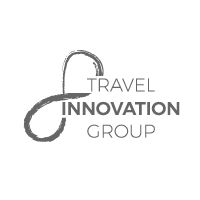
Our Group at a glance
With so many services under our belt, it can be difficult to summarise all the ways we serve you – so we made a video instead!

Our companies
We work hand-in-hand with airlines, cruise lines and hotels to deliver the best booking services to the travel trade.
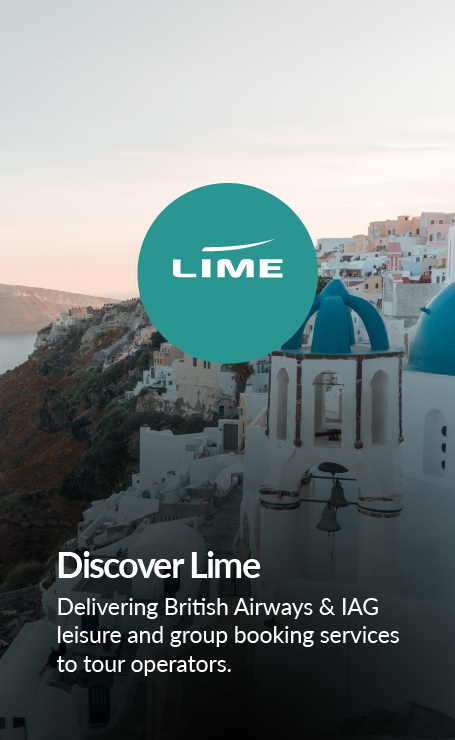
Our partners
luxury hotels
tour operators & travel agents
technology providers
cruise lines
How we got here.
It’s all about you, our valued partners. Our three companies are built on close relationships and understanding what you (and your customers) really need. You may be surprised by the breadth of services we offer as we manage many brands under Lime, Calrom and Aviate – sometimes from behind the scenes!
To provide a foundation for helping you reach new markets, the Travel Innovation Group was created to unify our brands in 2018. Ever since we’ve grown massively, but our agility, our core values (or Customs) and our people remain our greatest strengths.
Join our team
If you want to grow your skills and build a career where you’re in control, our opportunities could be right up your street.
- Our Customs
- Our Leadership team
- InfiniteAPI
- InfiniteCache
- InfiniteGateways
- InfiniteResourcing
- Ticket Protection Scheme
- South Africa Careers
- Pakistan Careers
- Barbados Careers
5 innovations transforming the travel industry

.chakra .wef-1c7l3mo{-webkit-transition:all 0.15s ease-out;transition:all 0.15s ease-out;cursor:pointer;-webkit-text-decoration:none;text-decoration:none;outline:none;color:inherit;}.chakra .wef-1c7l3mo:hover,.chakra .wef-1c7l3mo[data-hover]{-webkit-text-decoration:underline;text-decoration:underline;}.chakra .wef-1c7l3mo:focus,.chakra .wef-1c7l3mo[data-focus]{box-shadow:0 0 0 3px rgba(168,203,251,0.5);} Tiffany Misrahi

.chakra .wef-9dduvl{margin-top:16px;margin-bottom:16px;line-height:1.388;font-size:1.25rem;}@media screen and (min-width:56.5rem){.chakra .wef-9dduvl{font-size:1.125rem;}} Explore and monitor how .chakra .wef-15eoq1r{margin-top:16px;margin-bottom:16px;line-height:1.388;font-size:1.25rem;color:#F7DB5E;}@media screen and (min-width:56.5rem){.chakra .wef-15eoq1r{font-size:1.125rem;}} Supply Chain and Transport is affecting economies, industries and global issues

.chakra .wef-1nk5u5d{margin-top:16px;margin-bottom:16px;line-height:1.388;color:#2846F8;font-size:1.25rem;}@media screen and (min-width:56.5rem){.chakra .wef-1nk5u5d{font-size:1.125rem;}} Get involved with our crowdsourced digital platform to deliver impact at scale
Stay up to date:, supply chain and transport.
The 21 st century consumer is very different from previous generations. We are tech savvy and not only do we expect service quality, we want an experience to go with it. Given our unlimited access to information, we know what the gold standard is, and more importantly, we are open to sharing our experiences on social media and review platforms.

Although the travel industry is booming, with over 1.1 billion international global travelers in 2014, I haven’t met one person who has not complained about an experience they have had while traveling. So how can the industry make the experience more pain-free? There are obviously factors that are beyond the control of the industry, such as the weather, but like most other industries, there is room for innovation.
While many people are aware of some of the interesting innovations that are changing the way we experience travel, many are still under the radar:
- To share or not to share: The most obvious change in the last few years in hospitality is the sharing economy. The face of this movement is Airbnb, which is now valued at $25 billion, but there are many other companies that are playing the game, such as Couchsurfing, Feastly, Knok, Vayable or even Wimdu. While there are some regulatory issues around this new consumer model, it is providing accommodation to travelers who may not otherwise be able to afford it.
- Keep track of your bag: My biggest concern when I travel is losing my suitcase, and being left stranded for a business meeting whilst in sweatpants. But new innovations are changing this. Why, if we have smartphones, can’t we have smart suitcases? Well now we can. Different players are looking at different solutions. While airports like Las Vegas’ McCarran Terminal 3 are starting to attach a radio frequency identification chip to suitcases to ensure they don’t get lost, Bluesmart has created a carry on suitcase which can be controlled and tracked using an app on your phone.
- Let’s stay connected: We live in a hyperconnected world, where in-flight Wi-Fi was bound to happen – and it did. Although a number of airlines offer internet to passengers, it is not a perfect science and it is most definitely not free. But we have a choice which we didn’t have a few years ago. Airlines are also adding power outlets so that passengers can charge their devices throughout their flights and not arrive at their destination with a “dead” phone.
- Do it yourself: Today, I barely talk to anyone when I go through the airport. With the available technology, I am able to book my flight online, have my boarding pass on my phone, check in with machines, go through automated clearance gates and even validate my boarding pass to board the plane. These innovations have made navigating airports much more efficient – if you are tech savvy. Still, given that security is front of our minds, gate and security agents are present to make sure travelers can have a seamless experience.
- Guiding your experience: Guidebooks like Lonely Planet used to be the traveler’s bible – but have now become irrelevant in a world of websites and crowdsourcing sites which provide us with advice and reviews on hotels, tours and restaurants. Traditional online Travel Agencies like Expedia and Priceline have provided alternatives. But new players are on the market too: Peek puts a tour guide in your phone, while HotelTonight is a last minute hotel booking tool. Other players are also thinking differently about the issue, such as AnyRoad, which helps us connect to incredible guides and avoid travel agencies.
While these innovations are now the new norm, ten years ago, they would have been unheard of. As we look forward into the next decade, what innovations might continue to transform the way we travel?
The Annual Meeting of the New Champions 2015 is taking place in Dalian, China, from 9-11 September.
Have you read? The future of Chinese travel How to attract the tourists of tomorrow
Author: Tiffany Misrahi, Community Lead, Travel & Tourism Industries , World Economic Forum
Image: A mobile phone is connected to Wi-Fi network on board of the Norwegian Airways Boening 737-800 at Berlin Schoenefeld Airport April 2, 2015. REUTERS/Pawel Kopczynski
Share this:
- Share on Facebook (Opens in new window)
- Click to share on Twitter (Opens in new window)
- Click to share on LinkedIn (Opens in new window)
- Click to share on WhatsApp (Opens in new window)
Don't miss any update on this topic
Create a free account and access your personalized content collection with our latest publications and analyses.
License and Republishing
World Economic Forum articles may be republished in accordance with the Creative Commons Attribution-NonCommercial-NoDerivatives 4.0 International Public License, and in accordance with our Terms of Use.
The views expressed in this article are those of the author alone and not the World Economic Forum.
The Agenda .chakra .wef-n7bacu{margin-top:16px;margin-bottom:16px;line-height:1.388;font-weight:400;} Weekly
A weekly update of the most important issues driving the global agenda
.chakra .wef-1dtnjt5{display:-webkit-box;display:-webkit-flex;display:-ms-flexbox;display:flex;-webkit-align-items:center;-webkit-box-align:center;-ms-flex-align:center;align-items:center;-webkit-flex-wrap:wrap;-ms-flex-wrap:wrap;flex-wrap:wrap;} More on Supply Chains and Transportation .chakra .wef-17xejub{-webkit-flex:1;-ms-flex:1;flex:1;justify-self:stretch;-webkit-align-self:stretch;-ms-flex-item-align:stretch;align-self:stretch;} .chakra .wef-nr1rr4{display:-webkit-inline-box;display:-webkit-inline-flex;display:-ms-inline-flexbox;display:inline-flex;white-space:normal;vertical-align:middle;text-transform:uppercase;font-size:0.75rem;border-radius:0.25rem;font-weight:700;-webkit-align-items:center;-webkit-box-align:center;-ms-flex-align:center;align-items:center;line-height:1.2;-webkit-letter-spacing:1.25px;-moz-letter-spacing:1.25px;-ms-letter-spacing:1.25px;letter-spacing:1.25px;background:none;padding:0px;color:#B3B3B3;-webkit-box-decoration-break:clone;box-decoration-break:clone;-webkit-box-decoration-break:clone;}@media screen and (min-width:37.5rem){.chakra .wef-nr1rr4{font-size:0.875rem;}}@media screen and (min-width:56.5rem){.chakra .wef-nr1rr4{font-size:1rem;}} See all

How can innovation make mining more sustainable?
Robin Pomeroy, Emanuela Orsini and Sophia Akram
April 30, 2024

Policy tools for better labour outcomes
Maria Mexi and Mekhla Jha

Is the world replacing oil dependency with critical minerals?
David Victor and Joisa Saraiva
April 29, 2024

Why recycling metal is an opportunity too good to waste
Nick Pickens and Julian Kettle
April 22, 2024

Malaysia is emerging as a new semiconductor powerhouse

These highways charge electric trucks while they drive

Related Expertise: Transportation and Logistics , Airline Industry , Travel and Tourism
Innovation in Travel Must Put the Traveler First
May 21, 2019 By Nicolas Boutin , Jason Guggenheim , Jervin Justin , Pranay Jhunjhunwala , and Tom McCaleb
To understand the state of innovation in travel, it’s important to study both the industry’s startups and its incumbents. In our review of the past three years, we found that in general, innovation has slowed, and—especially for incumbents—that innovation should focus more strongly on the customer experience.
Investment activity is a strong proxy for the level of innovation among startups. In 2018, overall venture funding for travel startups dipped to a four-year low, while the underlying “pulse” of funding—excluding a small set of “unicorns,” startups valued at $1 billion or more—has been creeping up much more slowly than in the first half of this decade. (See Exhibit 1.) At the same time, the focus of those investments has shifted from North America to Asia, so travelers in Europe and the US are less likely to experience any innovations that those investments generate in the short run.

Meanwhile, among incumbents, recent innovation has focused on efficiency and unbundling services—in other words, imposing charges for services that had been included in the base price—rather than on features that improve the travel experience for customers. With the growing presence of machine learning, these companies have unparalleled opportunities to personalize customer journeys and protect their control of the customer relationship. For this reason, we are cautiously bullish about travel innovation. We formed this view after interviewing 25 experts from travel and tech companies, travel industry startups, corporate venture funds, and incubators.
We are cautiously bullish about travel innovation.
Copy Shareable Link
The expectations of our expert panel members were lower in 2019 than the extreme bullishness expressed in Travel Innovated: Who Will Own the Customer? . But the message is remarkably similar. Traditional travel companies—airlines, hotel chains, and cruise lines—have a choice. They can actively shape the experience of their customers—through both internal development and participation in the broader open innovation ecosystem—or cede that role to, for example, the large tech companies. Inaction is a tacit invitation to tech companies to burnish their reputations as customer-friendly innovators while travel companies are reduced to commodity providers of hotel rooms and airplane seats.
Follow the Money
Overall funding for travel startups declined from $31 billion in 2017 to $13 billion in 2018. But to present a clear picture of the state of innovation, we prefer to exclude unicorns, such as the now public Uber and Lyft. Their inclusion can skew the view of entrepreneurial activity because, in some cases, they, like Lyft, take on massive late-stage funding prior to going public. Excluding these companies, funding rose by nearly 10% from 2015 to 2018, far less than in the years prior to 2015. The growth in investments into younger, smaller companies suggests that investors still have an appetite for travel investments.
Two other noteworthy trends are the rise of corporate participation in the startup market and a shift of the center of gravity to Asia.
Corporate Buy-In. Corporations are contributing a greater share of overall travel startup funding than just a few years ago. In 2018, for example, corporations participated in 21% of travel startup financings, compared with 14% in 2013. The share of corporate financing—24%—was even higher in 2017, but the multiyear trend is upward, while the share of venture funding has been slipping over the past decade. Coupled with travel companies’ experimentation with inhouse incubators and digital factories, these trends suggest that travel companies are continuing to view innovation as a priority.
Corporations are also investing in earlier financing rounds. In 2018, for example, 56% of corporate financings were in seed, Series A, and Series B rounds. Those three rounds made up just 30% of corporate travel-financing activity in 2013. Nearly half, or 48%, of all corporate startup investments in 2013 were for acquisitions. In 2018, only 9% of these investments were for acquisitions. (See Exhibit 2.)

These trends suggest that incumbents are willing to look outside their organizations for innovation and fresh ideas. For their open-innovation efforts to pay off, effective partnering and integration are critical.
The Asian Surge. In the case of Asia, investors are following the miles. The Chinese airline travel market grew from 440 million passengers in 2013 to more than 600 million in 2018. By 2022, China will likely be—in terms of numbers of passengers—a larger air travel market than the US. It’s no wonder then that the share of travel startup investments in Asia rose from less than 20% ten years ago to 36% today. Asian investors are responsible for about 85% of these investments, which is about the same percentage of North American travel startups funded by North American investors.
Many of these startups are offering Asia-specific solutions that address holes in the continent’s travel infrastructure. For example, China does not have a long history of credit card networks, privately owned travel companies, or intermediaries. Accordingly, most of the Asian innovations are unlikely to translate into a change in the travel customer experience in North America or Europe anytime soon.
Recent Innovation: Efficiency Versus Experience
Over the past decade, the innovation efforts of travel companies—excluding digital natives such as Airbnb—have focused on unbundling and identifying ways to extract more money from customers, who do not consider having to pay for meals, checked bags, early check-in, inflight entertainment, or extra legroom beneficial forms of innovation.
These moves are, of course, necessary for preserving the companies’ financial health. At US-based Spirit Airlines, the world leader in generating ancillary revenues, add-ons generate about $55 per customer per flight. A revenue management team dynamically prices checked and carry-on bags and the cost of each seat, taking into account demand, flight duration, and customer profiles.
At the same time, however, passengers and guests are being exposed to much more enriching “customer journeys” when they, for example, engage in online shopping. Consequently, they expect comparable care and attention in their travels. Airlines’ mobile apps now allow customers to change flights, view upgrade and standby lists, track flights, and order rental cars, while hotel apps facilitate checking in and out, upgrades, messaging with the front desk, and keyless room entry. Many of these innovations, however, were driven less by a desire to improve the customer experience than to reduce operating costs. Many customers like these apps, but others find them impersonal and burdensome.
Travel companies face at least two obstacles in their pursuit of innovation. First, they operate with thin margins, so the cost of replacing or updating legacy IT systems can be prohibitive. Second, many travel companies are simply risk averse and reluctant to place long-term bets. Several travel companies, for example, have launched and shuttered in-house incubators because the payoff was too slow.
Opening the Door for Tech Companies. Aversion to risk and a focus on efficiency create room for others to offer innovations that customers actually want. In general, tech companies—with their reams of customer data, talented programmers, and willingness to experiment and take risks—are leading the way. For instance, Google—through its search, customer review, mapping, calendar integration, and real-time alert capabilities—has done far more recently than any other company to improve the customer experience in travel.
Avoiding the Commodity Trap. Superior customer experience is a positive not only for the customer. It can lead to price premiums and higher loyalty and advocacy for companies that do it well—all the more reason that travel companies should not cede the innovation landscape to the tech companies.
Changing the Game for Startups. Although they can be agile and flexible, startups do not have access to the consumer data and resources of large tech companies. Accordingly, many startups have pivoted away from serving consumers to working directly with established travel companies.
This shift has not been easy. Incumbents have been willing to work with startups on peripheral functions, but they are understandably reluctant to let them work on core functions such as reservations, revenue management, and hotel operations. Furthermore, they already have in-house systems in these areas or are working with established vendors such as Amadeus and Oracle.
Future Innovation: The Power of Machines to Improve Customer Journeys and Operations
Artificial intelligence (AI) was on the minds of the travel experts we interviewed. Three years ago, in a prior version of this publication, we described the power of data to help provide a smooth and personalized travel experience, but the experts did not even mention AI. The situation has changed. In our discussions with the experts, AI was the innovation topic that—after personalization and self-service and automation—they mentioned most often. (See Exhibit 3.)

Personalization. AI and personalization are complementary. Travel companies have large amounts of information—especially indicators of customer behavior collected through loyalty programs—that they do not fully exploit. On the basis of customers’ previous interactions, AI can help travel companies by noting which services customers have accessed in other trips or would likely enjoy.
AI can also make the hotel or cruise ship experience more seamless and personalized. Using facial-recognition technology, for example, Royal Caribbean promises passengers that they will be able to get “from car to bar in 10 minutes.” And with AI, hotel guests can be automatically assigned to the types of room that they have enjoyed in the past.
Travel companies have rich opportunities for reaching their customers in new ways with AI. Companies can draw on a wide variety of customer data to suggest trip ideas that are likely to be of greatest interest, and travelers can respond, quickly booking trips through a choice of platforms, including mobile devices, chatbots, and voice assistants such as Alexa and Siri. If a trip is a recurring offering, the company can automate bookings on the basis of information in each customer’s calendar.

Travel companies have rich opportunities for reaching their customers in new ways with AI.
Operational Improvements. Travel companies should not abandon their AI and other innovation efforts in operations. In fact, improved operations and customer experience go hand in hand. Customers often interact with several travel companies at different stages of their journeys. Many of these situations, involving, for example, weather-related delays or unforeseen mechanical breakdowns, are emotionally charged and beyond the companies’ control. Nonetheless, it’s not at all unusual for customers to hold the companies responsible. AI can help companies anticipate and prepare responses to such lapses even when they are not at fault.
AI can help airlines avoid disruptions. For example, Dutch airline KLM and BCG are working together to develop AI-enabled decision support tools that can help predict delays, optimize aircraft and crew scheduling, and improve the passenger experience. With these tools, an airline can quickly analyze many scenarios, taking into account crew positions and availability, aircraft locations, and maintenance programs. Armed with such analyses, frontline staff can make integrated decisions that boost operational performance. Qantas has developed AI routing models that reduce the risk of delays and turbulence while minimizing fuel, crew, and costs.
Many of these data-based innovations will require connecting data across systems and companies. Several experts said that the International Air Transport Association’s efforts to provide a common data standard (through New Distribution Capability), a single record (through ONE Order), and open software (through Open API) will help enable that connectivity. Others emphasized the need to make sure that customers receive value in exchange for agreeing to share their personal information and to comply with privacy regulations such as the EU’s General Data Protection Regulation.
Seemingly far-off innovations such as electric vertical takeoff and landing (eVTOL) and fully autonomous planes and cars may be available much sooner than many realize, but they are still several years away. (See the sidebar “Innovation in Flight.”)
Innovation in Flight
Recent innovation in travel has been modest, but several breakthrough technologies are nearing commercialization. In short-haul air travel, electric vertical takeoff and landing (eVTOL) air taxis and small fixed-wing electric aircraft are on the horizon. An on-demand eVTOL taxi will pick travelers up at their homes or offices and fly them directly to destinations within 500 miles. In January 2019, Boeing NeXt successfully tested an eVTOL aircraft: it took off, hovered, and landed on its own.
For trips of up to 700 miles, more cost-conscious travelers might opt for a hybrid jet or turboprop. These planes will offer lower-cost and more environmentally sustainable travel, even if the batteries are not yet economical for purely electric air travel. Boeing HorizonX and JetBlue Technology Ventures are backing Zunum Aero in its development of electric aircraft. With cruising speeds as high as 340 miles per hour and a cost-per-average seat mile of $.08, these aircraft could compete with traditional aircraft and open new routes. Zunum Aero aircraft can optionally be piloted remotely, helping address the pilot shortage. The company expects the first flight of its 12-seat aircraft in 2020. Subsequent models will be designed for up to 50 passengers.
Travel Companies Can Avoid the Commodity Trap by Working with Startups
Three years ago, we asked, How can travel suppliers protect their place in the value chain? The question remains relevant today, even if the context has changed. At the time, startups appeared to be a larger threat. Today, the tech companies are playing a more passive role than we had anticipated, funneling traffic to direct channels rather than competing directly against travel incumbents.
Even so, travel companies should be concerned about the risk of ending up as commodity providers while big tech companies own the customer relationships. Travel companies should be sharpening their focus on customer-centric innovations and improving the customer relationship—even at the risk of disrupting their own businesses. They certainly need to be willing to work with startups simply to gain access to their talent and creativity. These collaborations and partnerships will require changes in context in at least three areas.
Travel companies should be concerned about the risk of ending up as commodity providers while big tech companies own the customer relationships.
Alignment. Travel companies’ executives and middle managers need to be willing to work with startups and incorporate their innovations. To move beyond the not-invented-here mindset, travel companies will need to rethink their KPIs and incentives. For example, JetBlue tied the compensation and KPIs of senior executives to the success of its JetBlue Technology Ventures incubator. With the proper incentives in place, JetBlue executives now willingly work directly with the management teams of companies funded by the incubator.
Agility. Travel companies need to be able to create hassle-free partnerships with startups. And they need mechanisms for seamlessly connecting their IT systems with those of their partners. JetBlue Technology Ventures, for example, has built fast-track procedures that accelerate collaboration between portfolio companies and divisions of the airline.
In interviews, travel startup executives complained about the multiyear processes and high legal expenses they incur in partnering with travel companies, which too often try to push startup partnership development through extended procurement and legal processes designed for billion-dollar aircraft orders. Even if an initiative survives that gauntlet, complete implementation can sometimes take years.
Attitude. Travel companies need to take a more venture-capital-oriented approach to innovation. Travel executives seem to forget that nine out of ten startups—and internal innovation projects—fail. Even successes are unlikely to generate profits for a long time. It’s not unreasonable to expect a large travel company to manage a diversified portfolio of 30 to 50 internal projects and external partnerships.
Travel companies should view their partners as equals rather than subordinates. In too many cases, the travel company dictates contract terms—insisting, for example, on exclusivity—that turn off the startups with the best ideas. In fact, they should be willing to, like JetBlue Technology Ventures, introduce the startups to other companies in the travel industry.
To increase the odds that they benefit from rather than face the consequences of disruption, incumbents should welcome and engage with potential disruptors. JetBlue Technology Ventures’ involvement with Joby Aviation, an eVTOL startup, and Zunum Aero, a hybrid-electric-aircraft startup, exemplifies willingness to make long-term investments even at the risk of business model disruption.
Change in Context. With data a key element of many innovation trends, travel companies need to recapture the advantage that they have ceded to Google and others. It may make sense for industry participants to band together or for individual companies to work with their cobranded credit card partners to strengthen their understanding of their customers’ needs. At the same time, they should take steps to assure their customers that they will receive benefits in exchange for allowing the use of their data. This is ground that travel companies must recapture if they want to provide their customers with a seamless, friction-free, and relevant experience.
By developing a more open approach to innovation—especially when it benefits the customer experience—established travel companies can remain relevant in the face of competition from the large technology companies. Innovation is one way these companies can avoid being viewed— and ultimately valued—as providers of a commodity.

Managing Director & Senior Partner, Travel & Tourism Global Leader

Managing Director & Senior Partner

Managing Director & Partner
ABOUT BOSTON CONSULTING GROUP
Boston Consulting Group partners with leaders in business and society to tackle their most important challenges and capture their greatest opportunities. BCG was the pioneer in business strategy when it was founded in 1963. Today, we work closely with clients to embrace a transformational approach aimed at benefiting all stakeholders—empowering organizations to grow, build sustainable competitive advantage, and drive positive societal impact.
Our diverse, global teams bring deep industry and functional expertise and a range of perspectives that question the status quo and spark change. BCG delivers solutions through leading-edge management consulting, technology and design, and corporate and digital ventures. We work in a uniquely collaborative model across the firm and throughout all levels of the client organization, fueled by the goal of helping our clients thrive and enabling them to make the world a better place.
© Boston Consulting Group 2024. All rights reserved.
For information or permission to reprint, please contact BCG at [email protected] . To find the latest BCG content and register to receive e-alerts on this topic or others, please visit bcg.com . Follow Boston Consulting Group on Facebook and X (formerly Twitter) .
Subscribe to receive the latest insights on Consumer Products Industry.
Related content.

Competing on the Rate of Learning
New technologies operate at superhuman speed. Social, political, and economic forces move much more slowly. To use learning as a competitive advantage, companies must be able to learn on both timescales.

The Emerging Art of Ecosystem Management
Many companies are building or joining collaborative networks. The challenge is how to effectively set up and manage these ecosystems and use them strategically to maximize value—and gain a competitive edge.

Building a Resilient Business Inspired by Biology
Unprecedented levels of uncertainty threaten the architecture of many global firms. Six principles of biological systems can help companies address the unknown and the unknowable.

The Big Leap Toward AI at Scale
Companies are encountering the “AI paradox”: it is deceptively easy to launch projects with AI but fiendishly hard to reach scale.
The Evolution of Sustainable Travel

Saudi Tourism Authority + Skift
May 8th, 2024 at 11:20 AM EDT
In this episode of Skift Travel Spotlight podcast, Skift speaks with the Sustainable Hospitality Alliance at ITB Berlin about the power of innovation and education to build a more sustainable future.
Saudi Tourism Authority
This sponsored content was created in collaboration with a Skift partner.
Travel brands increasingly understand sustainability needs to be a fundamental part of their operations. However, putting this into practice can be difficult. In this episode, Glenn Mandziuk, CEO of Sustainable Hospitality Alliance, sat down with Kate Anderson, Creative Strategist at Skift, to discuss the evolving landscape of sustainable travel and the pivotal role collaboration and innovation play in shaping a more sustainable future for the industry.
🎧 Subscribe
Apple Podcasts | Spotify | Overcast | Google Podca sts
In this Podcast:
Changing Consumer Attitudes Towards Sustainability: Insights into the complexities behind consumer behavior and how the industry is navigating this dynamic to educate and empower travelers to make sustainable choices.
New Approaches to Sustainability: Behind the philosophy of net positive hospitality and innovative approaches to carbon footprint reduction, waste management, and social inclusion.
Hospitality Leadership: Why hospitality companies have a unique role to play in fostering sustainable behaviors among guests, even beyond check out.
Sustainability in Saudi Arabia: How starting from a blank canvas has enabled Saudi Arabia to integrate sustainability into its tourism development from the start.
This content was created collaboratively by Saudi Tourism Authority and Skift’s branded content studio, SkiftX .
Have a confidential tip for Skift? Get in touch
Tags: hospitality , neom , red sea global , saudi arabia , skift podcast , sustainability

Travel Innovation: How Technology Shapes Modern Journeys
Posted: November 1, 2023 | Last updated: November 1, 2023
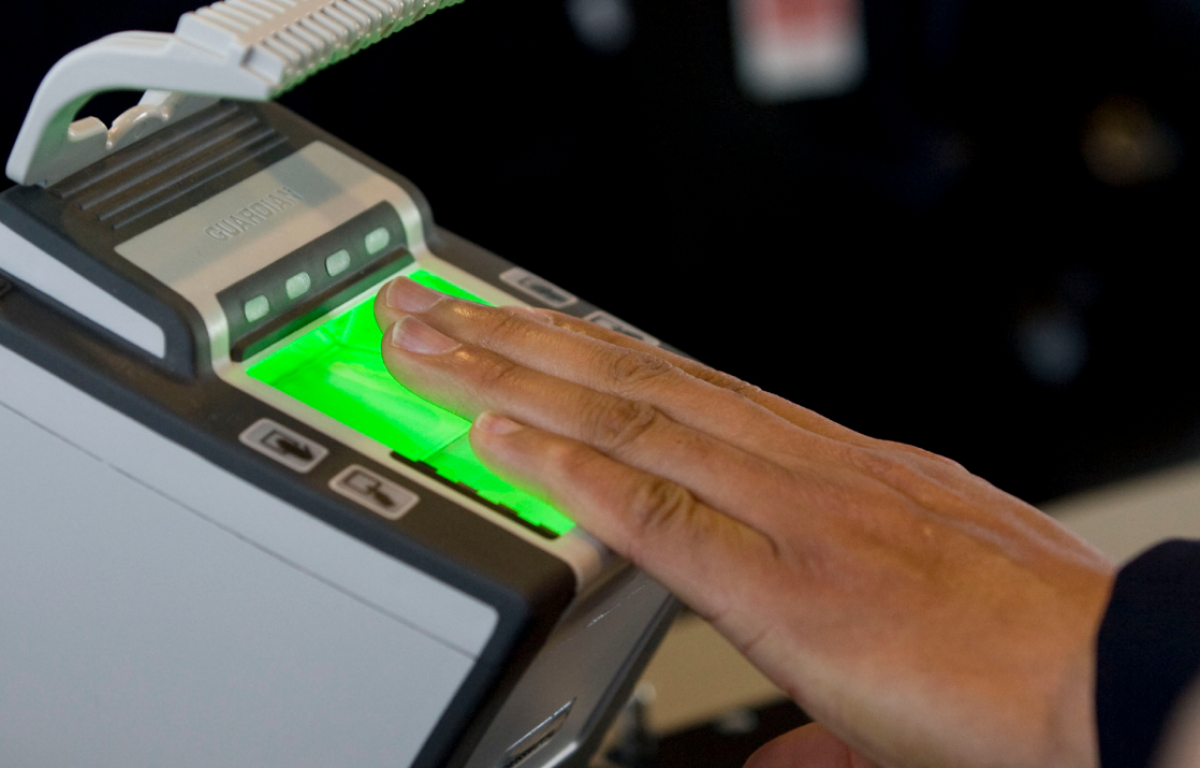
Safety is the number one priority for many people when it comes to traveling. Biometrics have helped make significant progress on that criteria. Biometric technologies like fingerprint scanning, facial recognition, and iris scanning offer a higher level of security compared to traditional identification methods.
Airport security and immigration processes have sped up thanks to biometrics, reducing wait times and eliminating the need for physical documents and manual verification. Biometrics also enable personalized travel experiences by linking individuals’ biometric data with their travel preferences and profiles.

Augmented Reality
Augmented reality apps help travelers by providing real-time information about particular places, attractions, and destinations. AR can help people navigate unfamiliar cities and learn about those places along the way.
Interactive guides, real-time translation, and personalized recommendations are some of the features that AR apps provide to travelers. They improve users’ engagement with the destination where they’re at and provide much-needed information when discovering new places and navigating unknown territories.

In a data-driven modern world, Big Data allows businesses to gather and process large amounts of data from travelers. This allows them to offer personalized travel experiences tailored to individual preferences, customized promotions, and personalized recommendations.
Big data enables businesses to gain a deeper understanding of customer needs and preferences. Business-wise, it analyzes market trends and demand patterns to optimize selling strategies and pricing. It also helps travelers improve their planning and trip management.

Autonomous Vehicles
While still in the early stages, autonomous vehicles promise to change the way we travel forever. Brands like Tesla and cities like San Francisco have begun experimenting with driverless vehicles. The main advantage of autonomous vehicles is that they can eliminate human error, which is the leading cause of accidents due to distractions, fatigue, or impaired driving.
They detect advanced sensors and cameras and use artificial intelligence algorithms to navigate and make decisions on the road. Autonomous vehicles also have the potential to increase accessibility and mobility for people who cannot drive.
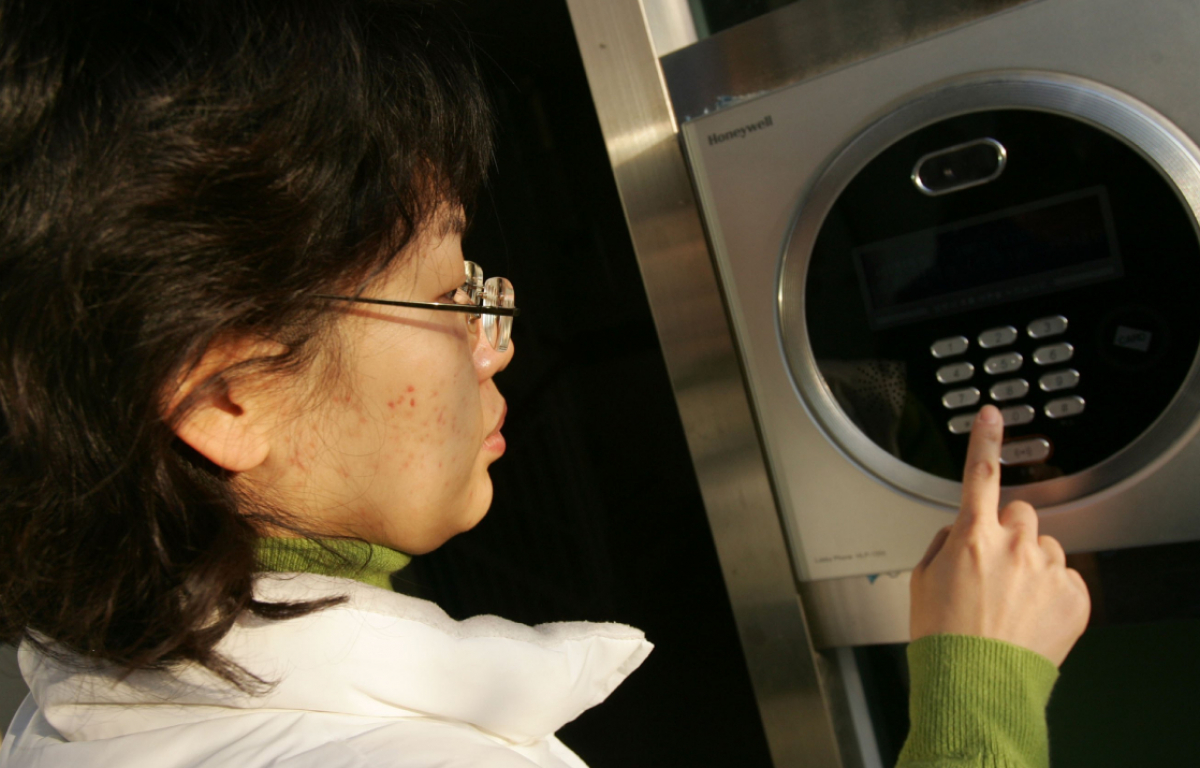
Internet of Things
The Internet of Things (IoT) describes the network of everyday objects connected to the internet via embedded devices with sensors, software, and other technologies. IoT devices have also impacted the travel experience.
Whether it’s smart luggage trackers or hotel room controls, these kinds of devices improve the traveler’s experience and organization. It also helps to ensure safety when traveling with devices such as smart surveillance systems equipped with IoT sensors.

Smart Travel Accessories
Smart travel accessories have solved many inconveniences and issues for travelers. For instance, portable Wi-Fi hotspots or smart travel routers enable travelers to stay connected to the internet while on the go, which is crucial when exploring unknown areas.
Some travel gadgets, like portable chargers, noise-canceling headphones, and smart suitcases with built-in GPS, enhance convenience and optimize travel. These kinds of smart accessories are also used for safety purposes.

When it comes to cybersecurity and transparency, blockchain technology has had a major impact on travel. Passenger identities and booking records are stored on the decentralized blockchain, reducing the risk of fraud, identity theft, and data breaches.
Blockchain technology also helps with payments. In the travel industry, the blockchain eliminates any intermediaries in the payment, like banks, enabling peer-to-peer (P2P) transactions, saving time and transaction costs, and enhancing transparency. It also plays a big part in loyalty programs, with the use of blockchain-based tokens or cryptocurrencies that allow more flexibility in the program’s rewards and can be redeemed through multiple participating travel providers.

Travel Sharing Platforms with User Reviews
One of the most important aspects of traveling is trusting the people who are in charge of the transportation, accommodations, tours, and other trip activities. Travel sharing platforms have gained a lot of popularity over the course of the years thanks to the facilities they provide for both parties to connect and interact.
Another key part of travel sharing platforms are the user-generated reviews and recommendations. Platforms like TripAdvisor and Yelp help travelers make informed decisions based on other travelers’ opinions.
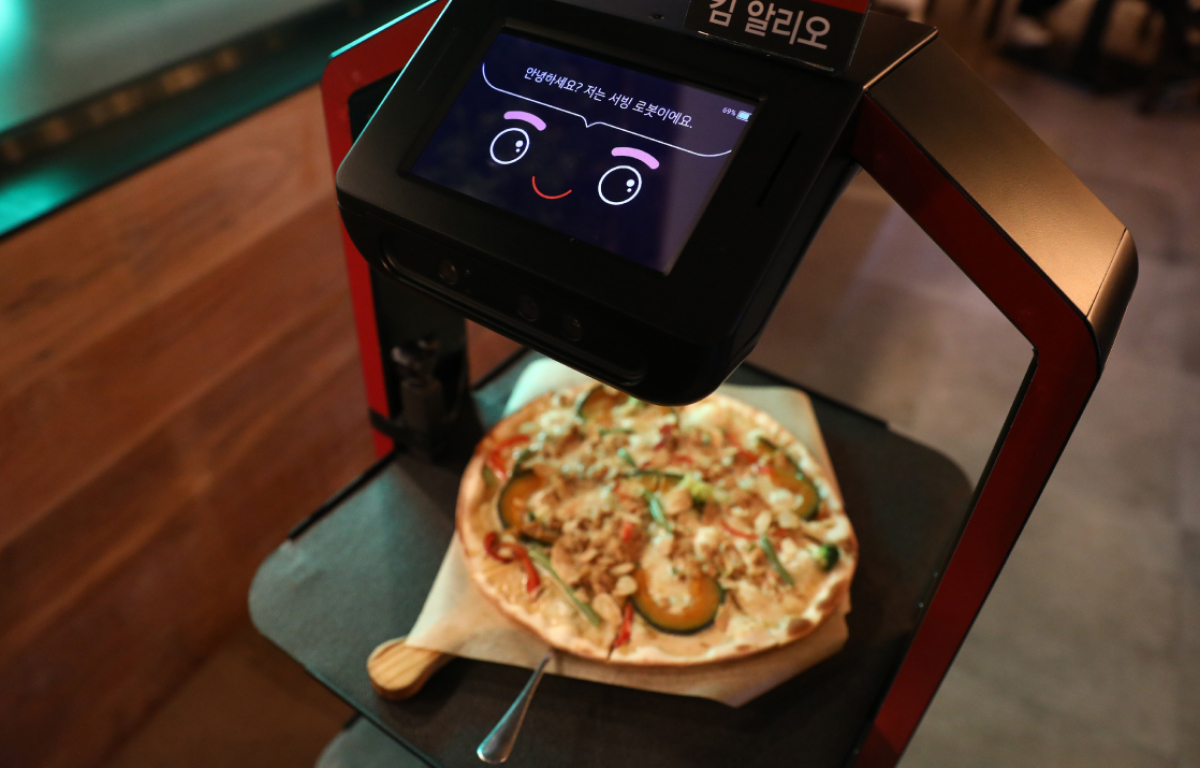
Artificial Intelligence (AI)
The AI takeover is real. Platforms like ChatGPT and Bard are regularly used by Internet consumers. When it comes to traveling, artificial intelligence can be very useful, and these chatbots can be used to provide information and assist with bookings.
AI algorithms can analyze large amounts of data, including user preferences and past travel behavior. Using that data, AI can offer personalized travel recommendations. For businesses in the tourism industry, AI algorithms can analyze market trends and demand patterns to generate selling strategies and offer the best prices to maximize revenue.
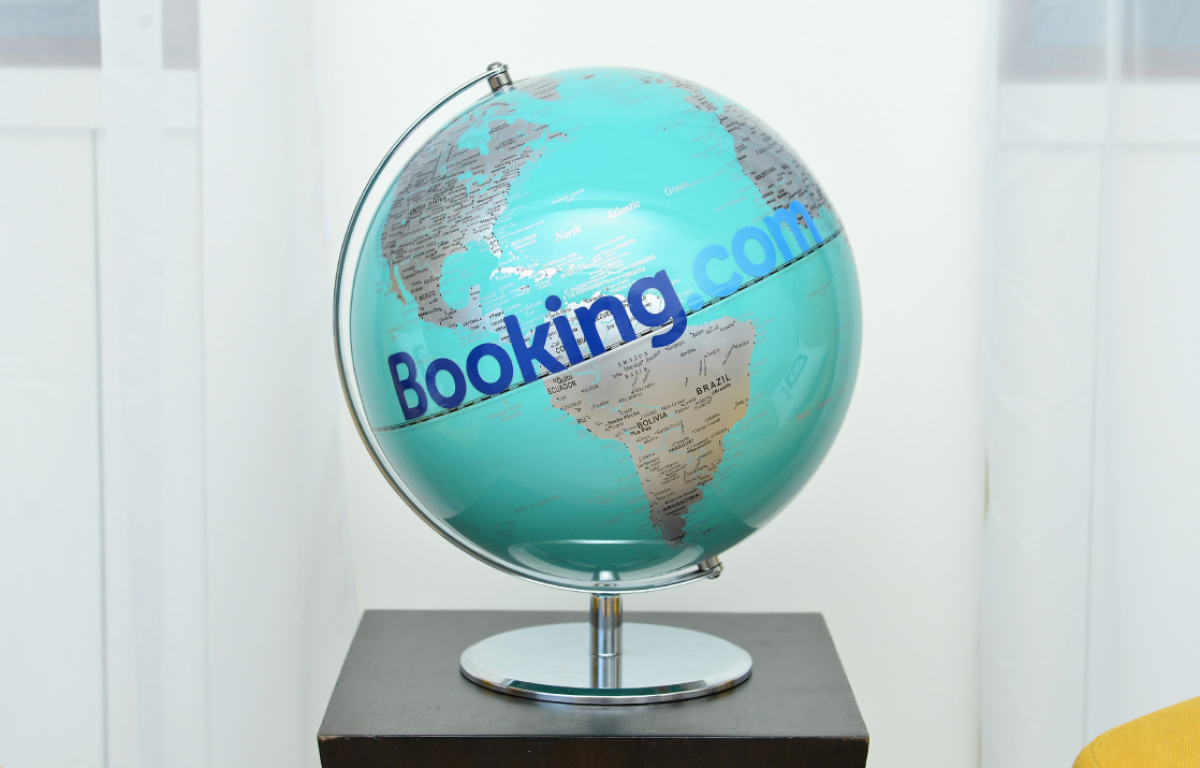
Online Travel Agencies (OTAs)
Online Travel Agencies have resolved many obstacles regarding travel accommodations. Platforms like Expedia, Booking.com, and Airbnb have made it easier to find and book accommodations wherever you go.
Providing a wide range of options and competitive prices, OTAs eliminate the need to visit multiple websites or make many phone calls to organize trips. User reviews and ratings, with 24/7 availability and customer support, have helped travelers get references about possible destinations and accommodations.

Mobile Apps
The days of using gigantic maps to move around unknown territory on your trips are over. Travel apps have changed the way we organize and manage every journey. It seems like every problem or issue can be easily resolved by just unlocking a smartphone and downloading different apps.
Airlines have their own apps to book flights. Some hotels and activities can also be booked through apps, while car rentals and tickets for other modes of transport can also be secured online. Moreover, any Maps application on smartphones can provide real-time information and even travel guides while spending time far from home.
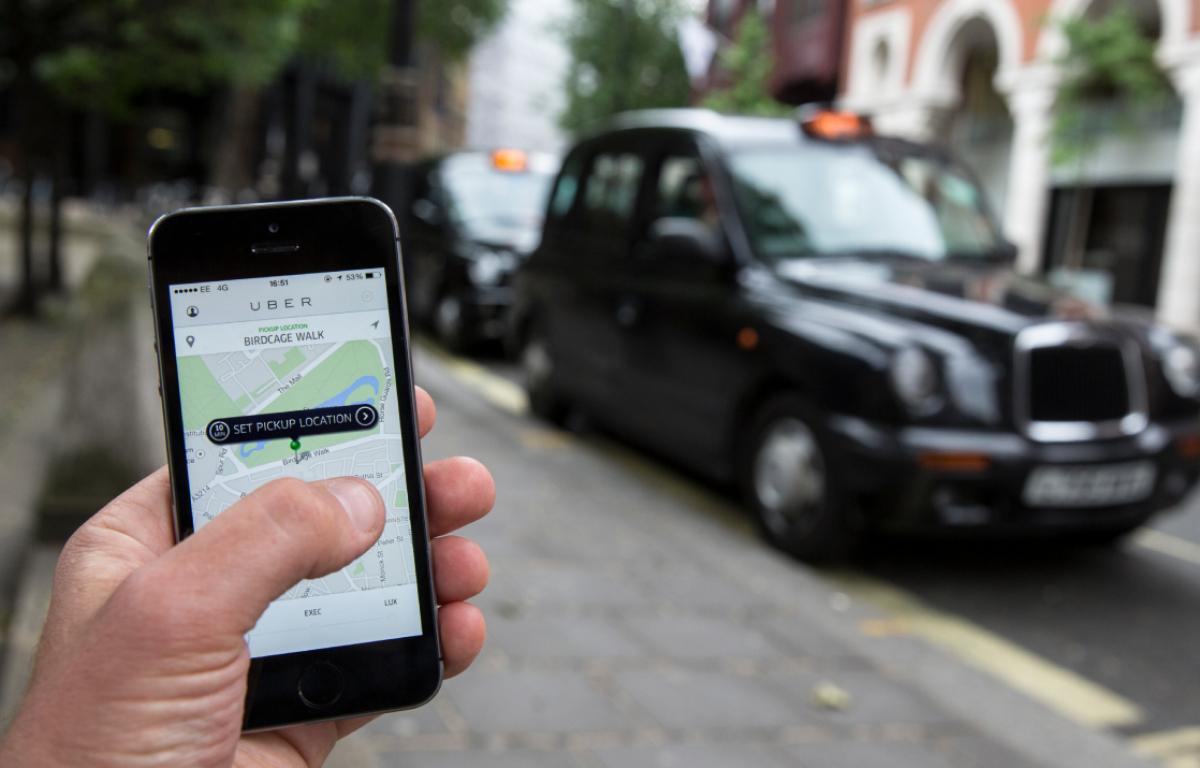
Ride-Sharing Services
The long-awaited alternatives to traditional car rentals and taxis have finally arrived in the last couple of years. Companies like Uber and Lyft have revolutionized transportation with their convenient ways of getting a car to move around a city.
Smartphone apps help travelers request a ride, track their driver’s location, and pay for the service without the need for cash. Pricing models, such as dynamic pricing based on supply and demand, can offer competitive rates, especially during non-peak hours when regular taxis are not available or hard to find in some cities. These companies usually offer safety and transparency by providing driver background checks, vehicle inspections, and real-time tracking of rides.

Mobile Payment Solutions
Mobile payment solutions have been playing a major role in the evolution of travel. In fact, the globalization of these payment solutions has enhanced travelers’ experiences wherever they go, reducing the need for physical cash.
Many mobile payment solutions are widely accepted globally, allowing travelers to make payments in different countries without dealing with currency exchange or international banking issues. It also provides financial inclusion by providing access to digital payment methods to people who may not have access to traditional banking services while on the move.

Virtual Reality
Technology has advanced so much that it allows us to travel to a certain place before actually going there. How? Virtual reality allows travelers to go through immersive experiences. Through VR headsets or immersive displays, users can virtually “step into” different locations, allowing them to explore and interact with their surroundings as if they were actually there.
These kinds of experiences can help people take a look at places that they haven’t been able to visit. It also provides helpful information that can help travelers make decisions ahead of their trip.

Electric and Hybrid Vehicles
In a world where there’s air pollution nearly everywhere, the transportation industry is trying to change that with electric and hybrid vehicles. The quest for environmental sustainability has allowed these vehicles to change the way we travel.
Electric and hybrid vehicles produce lower or zero carbon emissions, helping to fight air pollution, greenhouse gas emissions, and climate change. In that way, sustainable and eco-friendly travel can be achievable in countries that have and produce these kinds of vehicles.
More for You
Shaquille O'Neal-Shannon Sharpe beef reaches diss track level. Here's how we got here
I’m a Bank Teller: 3 Times You Should Never Ask For $100 Bills at the Bank
The Marine who was held longest as a Vietnam POW has passed away
This Is the Only Store-Bought Mayo That Julia Child Used
Shock Miss USA resignations are just the tip of the iceberg, insiders say
A stealthy cholesterol is killing people, and most don’t know they’re at risk
14 Scenes From the X-Files We’ll Never Forget
Sam Rubin, beloved LA entertainment anchor and interviewer, dies at 64
My husband and I divorced after 17 years of marriage. He sold our home at a significant profit. Am I entitled to my share?
I’m an Average Middle-Class Retiree: Here’s How Much Savings I Have
What Is Canadian Bacon?
Your Blood Type Affects Your Risk of Early Stroke, Scientists Discover
10 Hidden iOS 17.4 Features You'll Want To Start Using On Your iPhone
'The Waltons' Trivia: 15 Facts You Didn't Know About The Show
McDonald's hopes a $5 Meal Deal will win back inflation-weary customers
First Look At Maggie Q As Renée Ballard In ‘Bosch: Legacy' Crossover Episode; Jet Wilkinson To Direct Ballard Spinoff Pilot
US Housing Market To Be Upended This Summer: What To Know
‘Cheers’ star declares why he thinks working-class Americans support Trump: ‘He knows how to build things’
Law Roach Names "Big Five" Designers Who Refused to Dress Zendaya: "If You Say No, It'll Be a No Forever"
The Slick Tip For Cooling Down Your Mouth After Eating Spicy Food

Travel Innovation Club

The Travel Innovation Club is a network of players in the travel industry and beyond who come together to create a more seamless, enjoyable and innovative future of travel.
Company members, represented by executives and innovation experts, meet regularly to discuss traveler-centric business ideas, strategies and technological solutions.
Apply to become a member
If you are interested in being part of the Travel Innovation Club apply to become a member!
Build a strong network of travel executives and experts
Create working groups dedicated to achieve specific goals
Identify and experiment innovations that serve the travel industry in the short term or the long run
Position and expose our views and thought leadership to better serve the travel industry
Our company members belong to diverse segments of the travel industry – airlines, hospitality, travel agencies, airports, ground operators, startups- and beyond – tech players, innovation companies-. All members are represented by executives and innovation experts with a key role to foster innovation in their companies.
Current members:

Requirements to become a Club member
- Be a player of the travel industry and have business expertise that can serve one of the industry verticals.
- Support the purpose of the Club and accept to be bound by the Rules.
- Designate a representative in the company who is in charge of innovation related matters and is able to actively contribute to the Club and dedicate time.
- In case of SMEs, have more than 5 years of operations
- In case of Start-ups, the applicant must have an annual revenue of at least €300K
- In case of SMEs, have more than 5 years of operations.
The Travel Innovation Club organizes regular meetings with members:
- Bi-annual leadership meetings , to align on the priorities of the Club.
- Keynote speaker presentations, where relevant innovation topics are presented.
- Round tables , to discuss exploration areas.
These sessions also help pitch and vote the Exploration Squads that will be created to explore further on innovative ideas.
To attend these meetings, you need to be a member.

how we explore innovation
One of the benefits as members is to submit ideas to the Club to explore further. If several members are interested, they get together virtually and create an Exploration Squad .
Exploration Squads are the vehicles for members to research and come up with ideas and relevant deliverables on a topic. Once this exploration is completed, members can materialize ideas into real concepts outside the Club.
Privacy Overview
Enter your first name
Enter your last name
Enter your company
Enter a valid email
Enter your job title
It has been sent.
Enter your message

Moscow sets sights on revolutionary transport future by adding metro lines
Wednesday, April 10, 2024 Favorite

Moscow’s Mayor, Sergey Sobyanin, has recently announced the Moscow Transport Development Program, which is set to revolutionize the city’s transportation system by 2030. This ambitious initiative is designed to significantly decrease commuting times for more than 3.3 million residents of Moscow, potentially saving them up to half an hour each day.
- The program will introduce autonomous operation on metro Line 17, which is expected to lead to energy savings and heightened safety measures. Additionally, improvements are planned for the traction energy infrastructure, which will not only reduce waiting times during peak hours but also increase the frequency of trains, from 38 to 40 pairs per hour.
Tram services are also targeted for improvement under this program. The city has set a goal to increase the average tram speed to 18 kilometers per hour by 2030. This includes the construction of 10.3 kilometers of new tram lines and up to 10 kilometers of autonomous driving capabilities without overhead wires, utilizing hybrid supercapacitors produced domestically.
- A significant aspect of the program is the development of the Central Transport Hub and Russian High-Speed Rail. This initiative aims to enhance connectivity and reduce waiting times, making regional centers more accessible.
The program outlines a comprehensive plan for rolling stock renewal, with a focus on modernizing the metro trains, trams, and MCD trains by 2030. Moscow aims to establish itself as a pioneer in transport innovation through the introduction of the Moskva-2024 trains.
Investing in the workforce is a key priority, with plans to train up to 100,000 personnel annually by 2030. This includes offering 550 training programs to ensure the highest standards in transport services and infrastructure.
From a global perspective, Moscow’s transport development program illustrates a significant shift towards enhancing urban mobility and infrastructure. This initiative not only aims to improve the daily lives of Moscow’s residents but also positions the city as a leader in transport innovation and sustainability. Such advancements are likely to have a profound impact on the travel and tourism sector, making Moscow an even more attractive destination for visitors.
Meta description: Moscow announces ambitious transport development plan to enhance urban mobility by 2030, aiming to improve daily commutes and position the city as a leader in innovation.
Subscribe to our Newsletters

Related Posts
- Everything you need to know about Bahrain’s major global tourism projects
- Otley Road cycleway extension: A welcome boost for active travel
- EU launches Cultiv’arte to boost Mozambique’s cultural sector
- Land access issues halt Nunthorpe plan stalling sustainable vision
- NSW bolsters housing, councils resist change
Tags: Development , Infrastructure , innovation , moscow , sustainability , Transport , UrbanMobility

Select Your Language
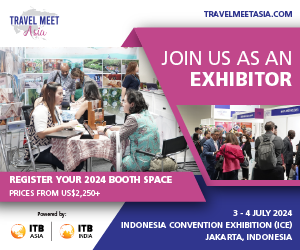
I want to receive travel news and trade event update from Travel And Tour World. I have read Travel And Tour World's Privacy Notice .
REGIONAL NEWS

Buenos Aires Horrific Train Collision in Palermo Leaves Ninety Wounded
Saturday, May 11, 2024

Eurostar Commits to 100% Renewable Energy for All Trains by 2030

Canadian Canoe Museum Unveils New Lakeside Campus

ASTA to Challenge Recent FAA Bill’s Neglect of Small Travel Agencies on Le
Middle east.

Luxury Travel Leaders Convene at Arabian Travel Market 2024 to Discuss Market Di

Israel Now Open to Tourists as Open Arms Invite Global Travelers to Rediscover I

Horrific Bus Plunge in St Petersburg, Russia Claims Seven Lives

China Embraces 11 European Nations with Visa-Free Entry, Pioneering Cultural Exc
Upcoming shows.
May 09 Seoul International Tourism Industry Fair (SITIF) 2024 May 9 - May 12 May 14 IMEX FRANKFURT May 14 - May 16 May 14 AFRICA’S TRAVEL INDABA May 14 - May 15 May 14 GBTA APAC Conference 2024 May 14 - May 15
Privacy Overview
- Knowledge Hub
- Product Status

Find a Data Set
- Browse All Data Sets
- Global Airline Schedules Data
- Flight Status Data
- Historical Flight Data
- Flight Seats Data
- Flight Emissions Data
- Minimum Connection Times
- Master Data
- Passenger Booking Data
- Global Flight Connections Data
- Airfare Data
How we deliver data
- Data Delivery
- Latest Product Updates
Data Suppliers
- Share your data
Try our Data
Flight data sets.
The world's most accurate and information-rich flight data
ANALYTICS PLATFORM
- Analyser Analytics Platform
EXPLORE ANALYSER MODULES
- Connections
DEMO ANALYSER PLATFORM
Powerful aviation analysis platform to drive commercial and operational decision making across the industry.
WE POWER THE AIR TRAVEL ECOSYSTEM
- Consultancies
- Governments & Security
- Travel Technology
- Airport Service Providers
TRUSTED BY LEADING ORGANISATIONS
- Air Black Box
- View All Case Studies
Springshot: Minimizing delays with OAG's Status Data
- All Blogs, Webinars & Podcasts
- Covid-19 Recovery
- Future of Travel
- Aviation Market Analysis
- Aviation Sustainability
- Data, Technology & Product
- Where To Meet Us
- Monthly Live Webinars
- Travel Recovery Tracker
- Busiest Flight Routes in the World
- Busiest Airports in the World
- Airline Frequency and Capacity Statistics
- Monthly OTP Analysis
- Middle East Market Analysis
- US Aviation Market Analysis
- South East Asia Market Analysis
- China Aviation Market Analysis
- View All Analysis
MIDDLE EAST AVIATION
Transformation, growth and future challenges.
Discover our latest in-depth report focused on the Middle East aviation market.
OUR COMPANY
- Diversity & Inclusion
- OAG & The Environment
- Our Locations
- What's New At OAG
GET IN TOUCH
- Press Office
Explore a career at OAG. See the latest job openings here.
Innovative Airline Operations: The Turnaround
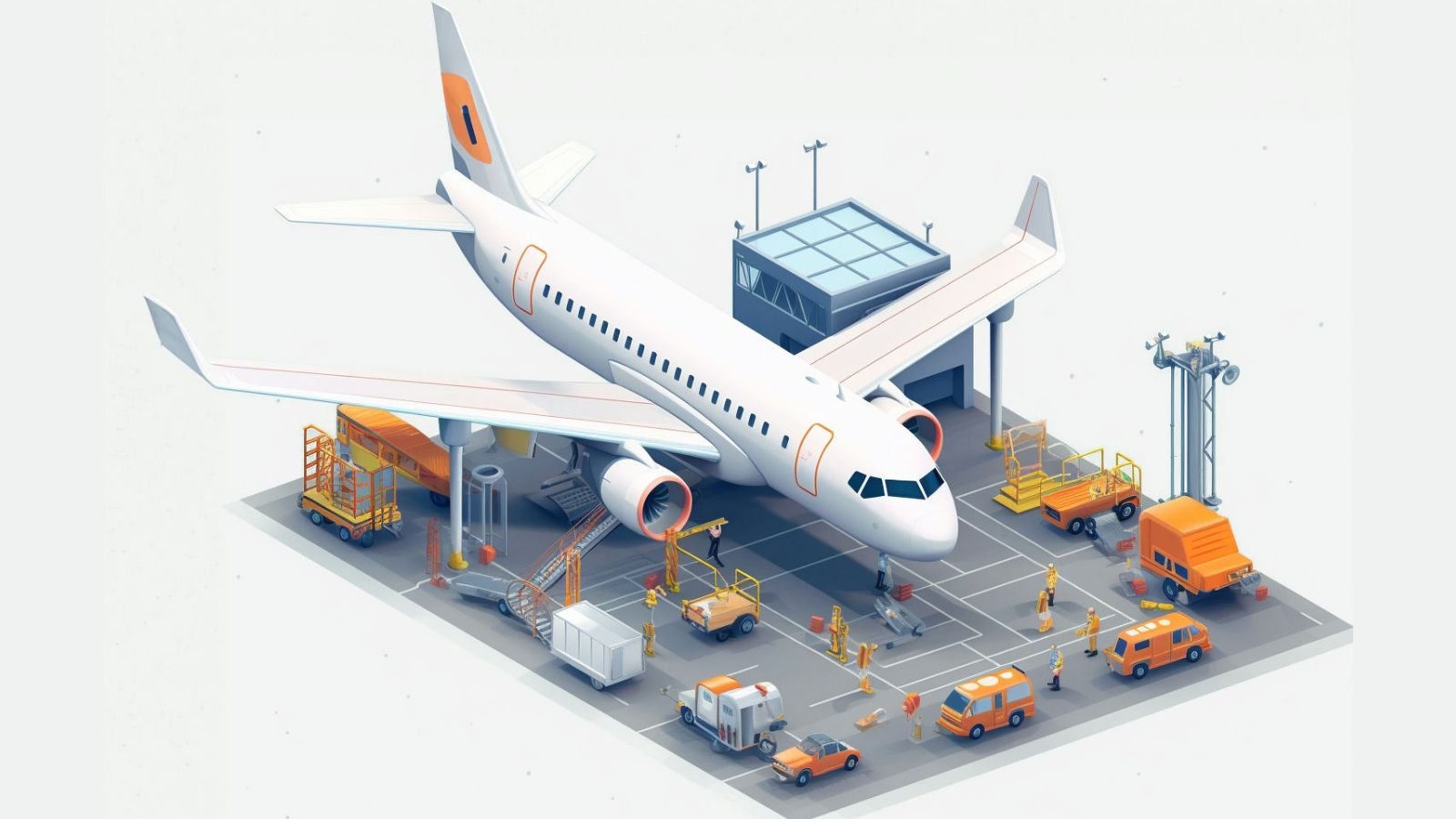
As the aviation sector continues its forward momentum, the transformative technology shifts aren't limited to just the airline retail experience we highlighted in our recent Airline Tech Transition Report .
There's another core segment of the airline ecosystem that's pivotal to its efficient functioning – airline operations.
Within the complex realm of airline operations, three pivotal areas stand out, each undergoing significant innovative overhauls that are reshaping traditional operational methods:
- Ramp Terminal Operations : Preparing the aircraft for its next journey.
- Flight Operations : Managing the aircraft while it's in the air.
- Post-Flight Operations : Streamlined management of luggage post-landing.
In this analysis, we'll take a closer look at the first of these critical areas – Ramp Terminal Operations – exploring its nuances and understanding its evolving role in the broader operational landscape of airlines.
.png?width=750&height=422&name=Slide1%20(1).png)
RAMP TERMINAL OPERATIONS: RACING AGAINST TIME
In the aviation world, the clock is always ticking!
Each minute holds monumental value, especially when aircraft are grounded. As the famous airline saying goes: planes don't make money sitting on the ground . The essence of an efficient airline operation lies in how promptly it can prepare an aircraft for its next journey – all while maintaining the highest safety standards and ensuring top-notch service.
As the airline industry constantly evolves, so do the methods and technologies that support it. Today, the emphasis on efficient Ramp Terminal Operations isn't just about manual precision but about leveraging cutting-edge technologies to ensure seamless operations.
The intricate dance that constitutes Ramp Terminal Operations revolves around swift yet organized coordination. This process isn’t merely about restocking amenities or refueling the aircraft. It involves orchestrating a multitude of stakeholders, for example, the strategic alignment between an airline’s fleet planning, schedule planning, passenger reservations, in-flight and ground operations, and especially airplane maintenance systems. Furthermore, this coordination extends to interactions with external entities such as air traffic controllers, airport authorities, and control authorities like immigration and customs. These latter elements add significant uncontrollable factors to the process, contrasting with the aspects airlines can control. This dichotomy between controllable and uncontrollable aspects is a critical consideration in the efficiency and success of the turnaround process.
As a result of this complexity, a single turnaround typically consists of hundreds of individual tasks, involving more than 75 different people and entities .
So, what drives this push for optimizing turnaround times, especially in today's rapidly evolving aviation landscape?
Let's dive into the three pivotal reasons that are more urgent now than ever before, underscoring the importance of shaving off every possible minute from the aircraft turnaround process.
WHY MINIMIZING TURNAROUND TIMES IS PARAMOUNT
Before an aircraft embarks on its next journey, it undergoes a crucial period of preparation. First, it remains stationed at the gate, allowing passengers to disembark, cargo and baggage to be unloaded, and necessary services, including refueling, cleaning, catering, and maintenance to be performed. Following this, cargo and baggage are loaded afresh, and a new set of passengers board. The time this cycle takes, averaged over numerous trips, is what the industry denotes as 'average turn-time'.
These average turn-times are constantly under pressure to be kept as short as possible.
Let’s briefly explore why.
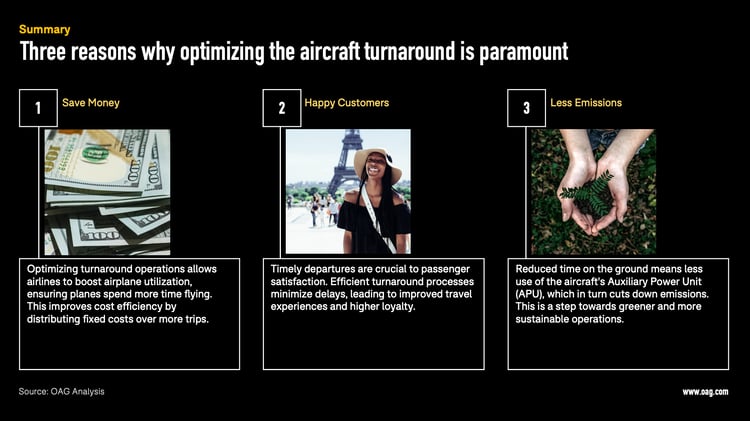
1. THE ECONOMIC IMPERATIVE OF EFFICIENT TURNAROUND
For airlines, time is money – quite literally. An airplane on the ground is usually an asset not generating revenue. Thus, the quest for minimizing average turn-time isn't merely operational but fundamentally economic.
This is especially true for low-cost airlines that rely heavily on quick turnarounds for efficient operations. However, it's important to note that for many legacy carriers, the equation can be more nuanced. For them, scheduling optimal connectivity in their hub-and-spoke systems often takes precedence. Additionally, in some cases, aircraft may need to remain on the ground for extended periods due to time differences and specific flying patterns. Thus, while efficient turnaround is universally valuable, its impact and implementation can vary significantly between different types of carriers.
In the case of budget airlines, the foremost consideration is airplane utilization. Especially for carriers championing point-to-point routes and those with shorter average trip lengths, efficient utilization is a key necessity. Such carriers typically adopt a streamlined approach: they employ a simplified fleet structure, limit airplane types, and emphasize high airplane utilization.
This lean operational model offers dual benefits:
- Firstly, with a limited variety of airplanes, swapping out an aircraft in case of unforeseen technical glitches becomes smoother.
- Secondly, elevated airplane utilization allows these airlines to distribute their fixed ownership expenditures across a larger number of flights, effectively diminishing costs on a per-seat-mile or per-trip basis.
Boeing's research crystallizes the economic significance of reducing turn-times. By shaving off a mere 10 minutes from the average turn-time (reducing it from 40 to 30 minutes), airplane utilization surges by an impressive 8% for a typical point-to-point carrier.
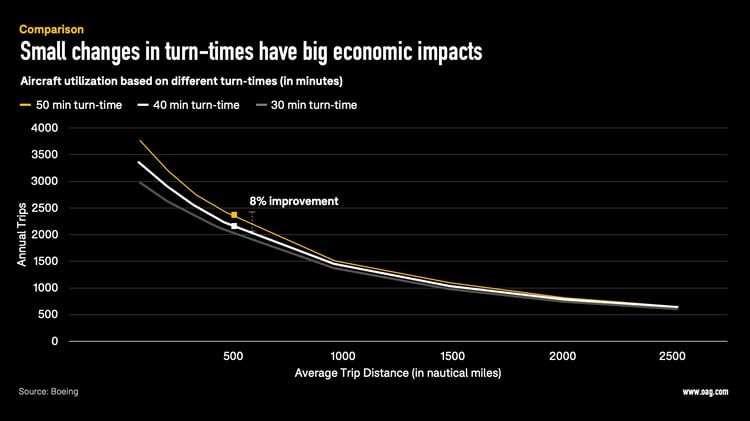
While the advantages of decreased turn-times are clear, assigning an exact monetary value to such reductions is challenging. Grounding costs are influenced by a myriad of factors, from the specifics of aircraft financing and aircraft type to variables like route specifics, fuel prices, load factors, and more.
While it's challenging to pinpoint an exact financial figure, the economic rationale for minimizing turn-times remains unquestionable. As such, the push for enhancing efficiency in turnaround operations is primarily about profitability.
2. The Passenger's Perspective on Turnaround Times
While airlines grapple with the economics of turnaround times, passengers are primarily concerned with another facet: punctuality.
Punctuality is not just about the flight departing and arriving on time. For many travelers, especially those on connecting flights, punctuality is crucial for ensuring connectivity. A delay in one segment can have a ripple effect, potentially causing passengers to miss their connecting flights and disrupting carefully planned itineraries. Therefore, maintaining strict adherence to scheduled turnaround times is essential not just for economic reasons and operational efficiency but also for ensuring that passengers can reliably reach their destinations or make their connecting flights without undue stress.
According to our proprietary OAG Flight Status Data , while a delay of about six minutes in planned turnaround can often be recuperated at some stage during a flight, anything beyond this window typically culminates in agonizing delays.
Data from our OAG analysis in March 2023 provides the regularity of this issue.
- Alarmingly, none of the major US airlines consistently achieved their aircraft turnarounds within the projected timeframes.
- United Airlines was the lone contender that managed to keep the variance within the six-minute gap between planned and actual turnaround times.
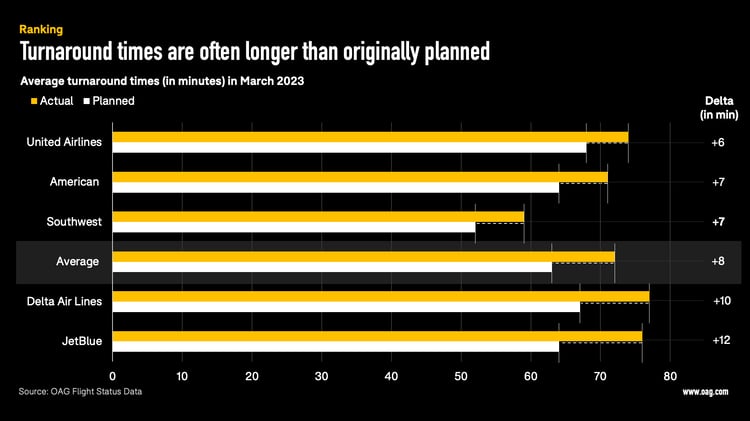
Our findings from March, while indicative, represent only a high-level view given the small sample size of 10 airports and 25 airlines. However, they do align with larger industry trends observed across various markets. According to the 2023 Turnaround Benchmark Report , the average ground delay, even among the best-performing short-haul airlines in the world (categorized as those in the top 75th percentile in terms of turnaround time), is an alarming eight minutes. This statistic highlights the significant challenges that even the most efficient airlines face in optimizing turnaround times.
What does all this mean for the average traveler?
Simply put, disruptions and discomfort.
- Recent studies indicate that flight delays feature prominently among the top three frustrations that air travelers complain about.
- Frost & Sullivan estimates that a 1% reduction in on-time performance in a given year results in a reduction of up to 0.6% of an airline’s net promoter score.
Thus, streamlined and punctual turnaround times aren't just an economic necessity – they're a core pillar of customer satisfaction. This holds true for all carriers, spanning the spectrum from short-haul point-to-point providers to long-haul legacy specialists.
3. The Green Angle of Turnaround Times
The call for sustainability is bellowing louder than ever, especially in the airline industry .
As stakeholders and passengers push for a “greener” travel experience , airlines are compelled to scrutinize every facet of their operations, from in-flight procedures to on-ground activities.
While the main engines might be silent during the turnaround, the aircraft is far from inactive. An essential player here is the aircraft's Auxiliary Power Unit (APU), typically nestled in the tail cone. Even with the main engines switched off, the APU runs, providing vital electrical and mechanical power. This includes maintaining air conditioning, powering essential cockpit systems, and eventually aiding in restarting the main engines.
While the APU serves a pivotal role, it’s not without its environmental footprint. Every minute of delay in turnaround times adds to the APU's operational duration. While the emissions might seem minor in isolation, they accumulate rapidly.
- Reducing each flight's turnaround time by just a single minute, thus cutting APU runtime, can lead to a CO2 reduction of over 3 kg – a seemingly modest amount.
- But when projected across the anticipated 32 million flights in 2023 , this translates to a staggering industry-wide savings of over 172 million kg of CO2.
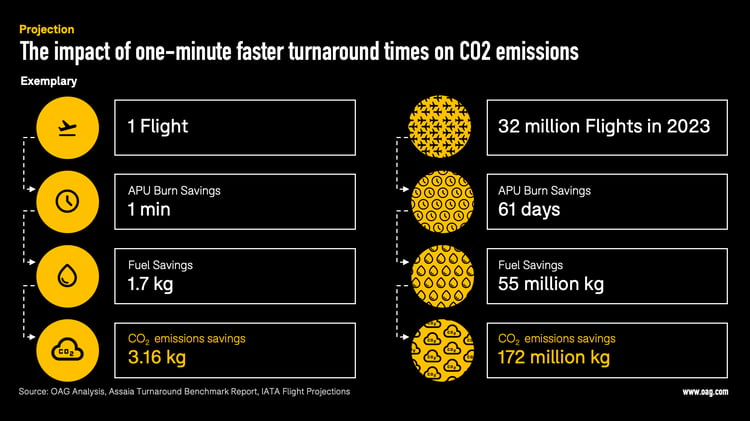
Recent research supports this savings potential:
- The Turnaround Report finds out that among the 25% least efficient airlines in terms of turnaround management, an average of 16 minutes of additional APU operation equates to a burn of approximately 27kg of extra fuel, translating to over 85kg of additional CO2 emissions.
- This Transport and Environment Study illuminates that accurate departure time forecasts would significantly trim down unnecessary APU emissions, reinforcing the importance of a tight turnaround schedule.
Notably, this carbon footprint could be effortlessly sidestepped if turnaround times adhered closely to the plan – no revolutionary electric or hydrogen-based jet engine needed.
So while many view sustainability through the lens of in-flight practices only, the significance of ground operations cannot be ignored. After all, every saved minute on the ground is a stride toward a greener tomorrow.

THE TECH BEHIND PERFECTING TURNAROUND TIMES
To appreciate the transformative potential of faster turnaround times, it's vital to evaluate how these improvements can be realized consistently and safely. The fusion of innovation and technology is the keystone to this advancement. This journey of innovation unfolds in three distinct phases:
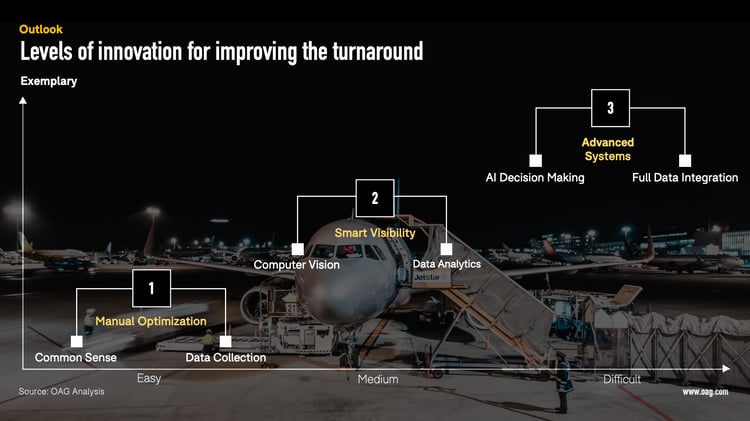
1. MANUAL OPTIMIZATION
At its core, this is about refining and rigorously standardizing turnaround processes. A consistent and clearly defined approach to turnaround processes like cleaning, cargo handling, and passenger boarding can significantly smooth operations. The more these processes are repeated, the more streamlined they become. This is when little windows of opportunity for improvement show up.
One compelling example showcases Delta Airlines' awareness: it tweaked the angle at which aircraft are pushed away from the gate. A shift from 90 degrees to 45 degrees saved the company just a minute or two each time, but these small increments, over time, prove monumental, as we learned above.
There are many other straightforward ideas to augment this efficiency further. While these manual optimizations are invaluable, they offer only limited upside potential. For more transformative shifts, technology-led innovation is imperative.
2. Smart Visibility
This second phase is anchored in leveraging today’s technology to keep a vigilant eye on ongoing processes and to enhance planning. A notable example is AeroCloud , which boosts its Airport Management Systems by combining flight data from multiple sources. This ensures a real-time, up-to-date single source of truth around flight activities, facilitating better planning for upcoming turnarounds.
Employing computer vision allows for real-time operational monitoring, flagging any deviations from optimal performance. Springshot is such a case in point. Developed in 2011, Springshot is an operations platform that provides aviation managers and planners with a unified control panel for smooth daily operations. By integrating our OAG data , Springshot equips airports and airlines with tools for accurate and balanced resource distribution. Its systems, fueled by automation, integrations, and AI, help save millions of dollars by preventing delays.
Assaia , a travel-tech startup from Switzerland, is another powerful example. The company’s partnership with airports, like the one in Halifax, Canada, employs a synergy of Artificial Intelligence and computer vision. Its solution can, for example, assist in efficient de-icing processes , a frequent cause of delays. By integrating data from the gates, the de-icing pad, and other essential inputs, the technology facilitates better coordination, minimizing blockages. Assaia's tech suite, with its real-time alerts and event detection capabilities, claims over 12% turnaround time improvements .
Other tech giants, including IBM , have also channeled their expertise into the turnaround domain, creating unified platforms to enhance collaboration and streamline operations. An array of tech solutions, from emerging startups like Aerogility and EXSYN to long-time tech pioneers like Honeywell and IBS Software , are also making waves in this space. Not to mention airline-owned solutions such as those from Lufthansa Systems .
What all these examples have in common is that they lie at the intersection of data, people, and technology, making sense of the data and connecting the right people.
3. The AI-Driven Future
The journey of innovation in airline operations is steadily integrating AI technologies, not only for monitoring and detecting but also for proactive adjustments that enhance operational efficiency.
A prime example of this unfolding AI future is the “ Deep Turnaround ” system at Amsterdam Schiphol Airport (AMS). This AI-driven solution, equipped with cameras, tracks over 70 steps in the aircraft turnaround process to predict its duration and estimate when a plane is ready to push back from the gate. Although still in its early stages, “Deep Turnaround” has already shown positive results and is not limited to Schiphol. Recently, it was revealed that this system is also being tested at other airports, including Eindhoven Airport .
With this in mind, imagine the expansive potential of such technology. For instance, an AI system could use real-time weather updates to foresee delays and automatically redirect fuel or cargo handling to another aircraft due for an imminent departure. This proactive adaptation ensures no time is wasted, resources are optimally utilized, and the integrity of the flight schedule is maintained. These advancements signal a future where AI not only tracks and reports but dynamically orchestrates operational decisions, leading to more efficient, timely, and sustainable airline operations.
This future vision underscores a seamless, automated ecosystem where every piece of data is not just collected but also actioned upon in real-time, ensuring optimal turnaround efficiency.
In wrapping up, it's clear that the most effective solutions for airlines emerge from the synergy of innovation, data, and technology. These elements serve as invaluable aids to dispatchers and movement controllers, offering enhanced visibility and informed decision-making. However, it's important to recognize that while these advancements significantly assist operational processes, they are not replacements for human insight. Commercial considerations and other critical factors still require human oversight and intervention. As the airline industry continues to evolve, the adept management of turnaround times, augmented by these technological aids, will play a crucial role in determining its future course and success.

We’re always adding new content, keep up to date by registering your interest here.
View our Privacy Notice
Related Insights
April's airline-tech innovations from google, aerocloud and southwest.
30 April 2024
Elevating the In-Flight Experience Through Innovation
16 April 2024
Three Tech Innovations Set to Transform the Passenger Experience and Operational Efficiency
03 April 2024
Jump to navigation
Search form

2024 Rahamimoff Travel Grants for Young Scientists
Research category, funding type, internal deadline.
Submit ticket request // Limit: 5 // Tickets Available: 4
Robert Ferrando (Applied Mathematics)
The Travel Grants Program is open to Ph.D. students doing research that requires facilities or expertise not available in their home country.
The program has two calls annually, each supporting 10 awards.
The awards are for $6,000 each.
The trips will be only to a higher education, or a research facility in the U.S.A. (for Israelis) or Israel (for U.S. students).
The program will not support participation in conferences, or trips by very early/late-stage Ph.D. students.
Each trip will be for a maximum length of 2 months. The awards must be utilized within 1 year of BSF notification. Applications for trips that have already occurred will not be accepted.
The BSF will only accept applications that are in the scientific fields it supports in its regular research grant program.
- Biomedical Engineering
- Life Sciences
- Psychobiology
- Exact and Physical Sciences
- Social Sciences
Eligibility:
- Applicants must be U.S. or Israeli citizens.
- The applicant, rather than his or her thesis advisor, must write the application.
- Applicants must be conducting supervised research towards a PhD in an accredited higher education institution, or in a non-profit research institution (government or other, including hospitals).
- Submitting an application before the PhD research program/plan is formally approved by the university is not recommended.
- Students in their last year of PhD studies are not eligible to submit applications to the program.
- Applicants must be 35 years old or younger.
- Israeli and American students doing research in the other country are not eligible to apply.
- A student who was previously awarded a grant in this program is not allowed to submit again.
- A student who was turned down may resubmit an application after 12 months, but only after receiving an approval from the BSF office. This approval will be given if an examination of the original submission will indicate that a resubmission has a good chance to succeed, for example if the application was submitted too early in the PhD study, and was otherwise excellent.
Program URL
External deadline, solicitation type.
Subscribe to the UArizona Impact in Action newsletter to receive featured stories and event info to connect you with UArizona's research, innovation, entrepreneurial ventures, and societal impacts.
Subscribe now
- Login Search
- Who We Serve
- Membership Benefits
- Membership Categories and Dues
- Join the RV Industry Association
- Get Involved
- RV Industry Awards Program
- Association and ANSI Adopted Standards
- RV and Park Model RV Handbooks
- Recognized Listing Agencies
- Standards News Bulletins
- RV Inspection Process and Deviation Database
- Standards Education
- Standards Test Questions
- Standards Regulatory & Legislative Reports
- Outdoor Recreation Roundtable
- Take Action
- State Guide for RV Manufacturers
- Monthly Shipment Report
- View All Monthly Shipment Reports
- Monthly RV Seals Report
- RV RoadSigns Quarterly Forecast
- Historical RV Data
- 2023 Vacation Cost Comparison Study
- 2023 RV Path to Purchase Journey
- 2023 RV Aftermarket Parts and Accessories Survey
- 2023 RV Industry Association Annual Report
- 2022 RVs Move America Economic Impact Study
- 2022 Campground Industry Market Analysis
- 2022 Survey of Lenders' Experiences
- 2022 RV Industry Profile
- 2021 Go RVing RV Owner Demographic Profile
- RVs Move America Week
- Leadership Conference
- RV Aftermarket Conference
- Upcoming Webinars
- Upcoming In-Person Seminars
- News & Insights
Geneva Long: Leading Innovation at Bowlus

As the CEO of Bowlus, Geneva Long is continuing the company’s legacy of luxury RV travel— a reputation that spans the last nine decades. Bowlus is a riveted aluminum travel trailer that was first designed and built by Hawley Bowlus in 1934. Currently, the company is based in Oxnard, CA. “Bowlus has quite a fascinating history,” Geneva reflects. “It was known in the 1930s era as a luxury travel trailer. Hawley Bowlus, who had previously built the Spirit of St Louis in 1927, returned to the aerospace industry during World War II and beyond.”
Geneva’s family has experienced its prominence firsthand. At the time, Geneva was completing her degree at the Wharton School of the University of Pennsylvania with her Bachelor of Science: “My family had a 1935 Bowlus Road Chief that was restored over many years, and we took it on a cross-country road trip. I was finishing up at Wharton at that time and I was interested in a career different from banking. The Bowlus’s ease of travel fostered a desire for road trip adventures.”
Throughout her family’s adventure across the country, their Bowlus received great interest from other RVers on the road. Geneva realized that there was a potential market for the product; additionally, the Bowlus name had not yet been trademarked. As a result, an ownership group led by Geneva was able to prototype the modern Bowlus over the course of a few years. The first modern Bowlus was produced in 2013.

During the last decade, Bowlus has positioned itself as an innovative leader in the RV market by implementing technological advancements in its products. The company provided its consumers with heated floors in 2014 and lithium power in 2016. Bowlus also turned its attention to the electric vehicle market, creating a fully electric Bowlus RV and making them model-wide in 2022. And just this year, Bowlus produced a self-powered, self-maneuvering remote-controlled RV. “We’re definitely always at the forefront of innovation,” says Geneva.
And Bowlus’s enterprising spirit won’t be stopping anytime soon: “We started our first dealer relationships in late 2023 and we’ll be continuing that expansion. We hope to have Bowlus dealers close to all major markets within the next year and we’re excited to bring that closer to customers.”
“We’re continuing to innovate as well. We launched the 2025 Bowlus Rivet, which has a lower cost but it’s still in the premium segment. We’ve proven that there is a market for premium towables. And now that we’ve proven that we’re an established player for quality and lightweight, we’re now ready to enter that premium segment at a price point that’s popular with both consumers and dealers.”

Along with her duties at Bowlus, Geneva has also begun taking on a larger role with the RV Industry Association. She is currently in the process of joining the Public Relations Committee and the Emerging Leaders Coalition.
Additionally, she has begun attending events hosted by the RV Industry Association. “Bowlus recently joined the Association and we attended the March Leadership Conference. We’re so impressed with all of the effort that Craig Kirby and his team put into an event like that,” Geneva says. “The people we met were fantastic and the panelists were wonderful. It was just a wonderful week. It’s impressive seeing everyone come together as an industry.”
Please Sign in to View
Log in to view member-only content..
If you believe you are receiving this message in error contact us at [email protected] .
US Map - State Name will appear here when state is selected
RV Industry Association uses cookies on rvia.org in accordance with our privacy policy . By using this site, you consent to the use of cookies. We use cookies for the following purposes: To enable certain functions of the service, to provide analytics, to store your preferences, and to enable advertisements delivery, including behavioral advertising.
Related Travel Research
Travel innovation and technology trends 2021.
Free for Open Access Subscribers
Each year, Phocuswright publishes a content series that identifies some of the most significant trends in travel technology and distribution for the upcoming year and beyond. Needless to say, the COVID-19 pandemic has shaken the travel industry and forced suppliers and intermediaries alike to rethink their focus. Innovation in travel is more important than ever, and technology will play a pivotal role in market recovery and transformation. This report features introductions to the following topics that will be explored throughout the year:
- End-to-End Touchless Journeys
- For Real Recovery, Digitization Is a Must
- Health and Immunity Passports: Can Travel Get it Right?
- Traveler Health and Safety: Tech to the Rescue
- AI in Travel: Separating Reality From Rhetoric
- The Decentralized Computing Future
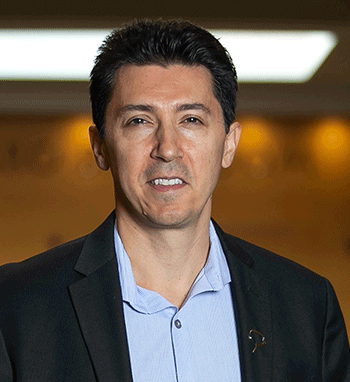
What is Open Access
An Open Access subscription provides company-wide access to the whole library of Phocuswright’s travel research and data visualization.
Curious? Contact our team to learn more:
What is open access+.
With Open Access+, your company gets access to Phocuswright's full travel research library and data visualization PLUS Special Project deliverables.
Provide your information and we'll contact you:
Curious contact our team to learn more:.
PRESSR: Radisson Hotel Group showcases commitment to sustainability and innovation at ATM 2024
Radisson Hotel Group, one of the world's largest hotel groups, is proud to participate in this year’s Arabian Travel Market, underscoring its continued dedication to sustainability, innovation, and responsible business. As part of the Group’s Responsible Business initiatives, this year marks the 35th anniversary of Radisson’s pioneering environmental policy.
Radisson Hotel Group has made significant strides toward its Net Zero 2050 goal, with impactful advancements in carbon footprint reduction, employee engagement and diversity. Tim Cordon , Chief Operating Officer for MEA & SEAP, “ Our dedication to sustainability is unwavering, and we’re excited to showcase our Responsible Business achievements–it's clear that Radisson is not just part of the industry’s sustainable journey but is driving it forward. By pushing the envelope in sustainable practices and convening the industry to meet consumer demand for green travel, we aim to be a driving force for change.” Cordon continues, “Our Responsible Business program, including our substantial carbon footprint reduction and the roll-out of Hotel Sustainability Basics, represents our promise and action towards a greener future."
Radisson Hotel Group is breaking new ground with its Radisson Meetings Unbound platform and the AI-powered Radisson Meetings Dream Machine by leveraging digital innovation and empowering event professionals with AI to envision and co-create extraordinary meeting experiences. Radisson’s digital platforms, such as the online Radisson Meetings Dream Machine, offer event planners immersive virtual tours and the ability to design event spaces digitally, enhancing the planning experience and allowing them to preview and tailor events with unprecedented ease and flexibility. Radisson Meetings Unbound demonstrates the Group’s focus on digital innovation, which has cemented its status as a leading digital innovation visionary. In addition, the Radisson Rewards program aligns with this focus towards enhancing the guest experience. Providing exceptional value, the program offers members immediate benefits and the ability to contribute to sustainability through carbon offset options.
The Radisson Meetings Unbound initiative is enhanced by the introduction of "infinity rooms"—an immersive experience designed to help event planners broaden their approach to meetings and events. This feature promotes collaboration and innovation, embodying Radisson Hotel Group’s commitment to redefining the meeting experience. It acts as a conduit between today's ideas and tomorrow's realities, combining a personal touch with state-of-the-art technology to meet the evolving needs of their guests.
As Radisson Hotel Group marches towards Net Zero by 2050, its ongoing initiatives, such as reducing greenhouse gas emissions by 46% by 2030, reflect its steadfast commitment to sustainable and responsible business practices. "As we join hands with our peers at the Arabian Travel Market, our message is clear – sustainability and innovation are not just part of our strategy; they are ingrained in every action we take," concludes Cordon . “From our efforts to reduce emissions to our digital platforms that revolutionize event planning, we are setting the stage for a future where every moment matters, and every action counts toward a more sustainable, innovative, and guest-centric hospitality experience.
MEDIA CONTACT:
Caroline Jonsson, Regional PR & Communications Manager Middle East
ABOUT RADISSON HOTEL GROUP
Radisson Hotel Group is an international hotel group operating in EMEA and APAC. With over 1,340 hotels in operation and under development in more than 95 countries, the group is rapidly expanding and plans to grow its portfolio significantly. The Group’s overarching brand promise is Every Moment Matters, with a signature Yes, I Can! service ethos.
The Radisson family of brands portfolio includes Radisson Collection, art’otel, Radisson Blu, Radisson, Radisson RED, Radisson Individuals, Park Plaza, Park Inn by Radisson, Country Inn & Suites by Radisson, and prizeotel brought together under one commercial umbrella brand Radisson Hotels.
Radisson Rewards is Radisson Hotel Group’s loyalty program, which delivers an elevated experience that makes Every Moment Matter. As the most streamlined program in the sector, members enjoy exceptional advantages and can access their benefits from day one across a wide range of hotels in Europe, Middle East, Africa, and Asia Pacific.
Radisson Meetings provides tailored solutions for any event or meeting, including hybrid solutions placing guests and their needs at the heart of its offer. Radisson Meetings is built around three strong service commitments: Personal, Professional and Memorable, while delivering on the brilliant basics and being uniquely 100% Carbon Neutral.
At Radisson Hotel Group we care for people, communities and planet and aim to be Net Zero by 2050 based on the approved near-term Science Based Targets. With unique solutions such as 100% carbon neutral Radisson Meetings, we make sustainable hotel stays easy. To facilitate sustainable travel choices, all our hotels are becoming verified on Hotel Sustainability Basics.
The health and safety of guests and team members remain a top priority for Radisson Hotel Group. All properties across the Group’s portfolio are subject to health and safety requirements, ensuring we always care for our guests and team members.
For more information, visit our corporate website.
Disclaimer: The contents of this press release was provided from an external third party provider. This website is not responsible for, and does not control, such external content. This content is provided on an “as is” and “as available” basis and has not been edited in any way. Neither this website nor our affiliates guarantee the accuracy of or endorse the views or opinions expressed in this press release.
The press release is provided for informational purposes only. The content does not provide tax, legal or investment advice or opinion regarding the suitability, value or profitability of any particular security, portfolio or investment strategy. Neither this website nor our affiliates shall be liable for any errors or inaccuracies in the content, or for any actions taken by you in reliance thereon. You expressly agree that your use of the information within this article is at your sole risk.
To the fullest extent permitted by applicable law, this website, its parent company, its subsidiaries, its affiliates and the respective shareholders, directors, officers, employees, agents, advertisers, content providers and licensors will not be liable (jointly or severally) to you for any direct, indirect, consequential, special, incidental, punitive or exemplary damages, including without limitation, lost profits, lost savings and lost revenues, whether in negligence, tort, contract or any other theory of liability, even if the parties have been advised of the possibility or could have foreseen any such damages.
- Diversity, Equity & Inclusion at Delta
- Racial and Ethnic Diversity
- LGBTQ+ Diversity
- People with Disabilities
- Veterans and the Military
- Sustainability
- Awards & Recognition
- Global Partners
This past Saturday, Delta CEO Ed Bastian received an honorary doctorate degree and delivered the commencement address at Georgia Institute of Technology’s McCamish Pavilion.
Before Bastian addressed the graduates, Georgia Tech President Ángel Cabrera presented him with an honorary degree — the most significant honor a university can bestow upon an individual for their significant contributions to a specific field or society in general.
“One thing that I think tested all of us was the unprecedented pandemic we had to go through,” said Cabrera. “I haven’t met a better leader during those very, very difficult years than Ed Bastian. Not only for what he was doing at Delta, but because of the example that he was setting for the rest of us. And that’s why we’re honoring Ed today.”
After receiving his degree, Bastian gave advice to the bachelor’s and master’s students as they begin the next step of their journeys.
“You are stepping into a world that needs you, more than ever,” said Bastian. “Your energy, passion, creativity, and hope. Our world is ready to be led by those who don’t run from their fears but lead through them.”
Delta Air Lines and The Delta Air Lines Foundation have a long history of supporting Georgia Tech. Delta is a sponsor of Georgia Tech Athletics and has a close association with the Engineering School through their co-op program.
Bastian served as the fourth speaker of five that celebrated the almost 6,000 Georgia Tech graduates. Other commencement speakers included Professor Baratunde Cola, Georgia Power CEO Kim Greene, entrepreneur Chris Klaus and McKinsey & Company Managing Partner Tiffany Burns.
To watch his complete speech, view the video below. Bastian's portion begins at 1:16:12.
Related Other Media

Not finding what you need?
- International edition
- Australia edition
- Europe edition

ChatGPT and the like could free up coders to new heights of creativity

Far from making programmers an endangered species, AI will release them from the grunt work that stifles innovation
W hen digital computers were invented, the first task was to instruct them to do what we wanted. The problem was that the machines didn’t understand English – they only knew ones and zeros. You could program them with long sequences of these two digits and if you got the sequence right then the machines would do what you wanted. But life’s too short for composing infinite strings of ones and zeros, so we began designing programming languages that allowed us to express our wishes in a human-readable form that could then be translated (by a piece of software called a “compiler”) into terms that machines could understand and obey.
Over the next 60 years or so, these programming languages – with names such as Fortran, Basic, Algol, COBOL, PL/1, LISP, C, C++, Python – proliferated like rabbits, so that there are now many hundreds, perhaps even thousands, of them. At any rate, it takes quite a while to scroll down to the end of the Wikipedia page that lists them . Some are very specialised, others more general, and over the years programmers created libraries of snippets of code (called subroutines ) for common tasks – searching and sorting, for example – that you could incorporate when writing a particular program.
For more than half a century, therefore, an arcane, exclusive priesthood evolved, of people who had mastered one or more of these specialised languages and were able to make computers do their bidding. Membership of the priesthood gave one an intoxicating feeling of absolute power. In software, remember, you can program a set of pixels to move endlessly in a circle, say, and they will continue to do that for ever if you leave them to it. They need neither fuel nor food, and they will never complain. “In that sense,” I once wrote when writing a history of this technology, “being a programmer is like being Napoleon before the retreat from Moscow. Software is the only medium in which the limits are exclusively those set by your imagination.”
This is why, when large language models (LLMs) such as ChatGPT emerged, many people were flabbergasted to discover that not only could these machines compose coherent English sentences, but they could also write computer programs ! Instead of having to master the byzantine intricacies of C++ or Python in order to converse with the machine, you could explain what you wanted it to do and it would spit out the necessary code. You could program the machine in plain English!
How was this possible? Essentially because, in its training phase, the machine has ingested a lot of published computer code – just as it has also ingested virtually every examination paper that has ever been published. And although the computer code that it produces often has flaws in it, they can often be ironed out in successive iterations. The technology is already pretty good, which is why programmers have been early adopters of it as a kind of “co-pilot” . And it will get steadily better.
So are we seeing the twilight of the software priesthood, as some of the more apocalyptic reactions to LLMs claim? Personally I doubt it, if only because we always overestimate the short-term impact of tech change, while underestimating its longer-term effects. What these AI “co-pilots” really do is take the grunt work out of programming, freeing those who understand software to do more interesting and productive things.
When GitHub, the programmers’ repository owned by Microsoft, quizzed more than 2,000 professional software professionals about the technology, the results supported that view: 88% said that it made them more productive; 59% said it made the job less frustrating; 74% said that it had enabled them to focus on “more satisfying work”; 96% found that it made them faster when doing repetitive tasks; and 77% said that they now spent less time searching. This is the image not of Armageddon, but of something more positive.
And already, AI co-pilots are beginning to change how programming itself is taught. Most introductory computer science courses tended to focus on code syntax and getting programs to run, and while knowing how to read and write code is still essential, testing and debugging now need to be taught more explicitly. Academics are finding that the fact that students are using AI tools frees up time “to teach higher-level thinking – for example, how to design software, what is the right problem to solve, and what are the solutions? Students can spend more time on optimisation, ethical issues and the user-friendliness of a system rather than focusing on the syntax of the code.”
Mario Fusco, a great software developer, once said: “The code you write makes you a programmer. The code you delete makes you a good one. The code you don’t have to write makes you a great one.” So maybe, for once, AI is on to something.
after newsletter promotion
What I’ve been reading
Student disunion Very perceptive blogpost , Universities As Factories, by the economist Branko Milanovic about the Columbia demonstrations.
Short is sweet The Tyranny of Content Algorithms : a succinct essay on the importance of quality over quantity by Silicon Valley veteran Om Malik.
Where Walter went wrong What Elon Musk’s Favourite Game Tells Us About Him is the title of Dave Karpf’s blistering critique of Musk’s biographer, Walter Isaacson.
- Artificial intelligence (AI)
- Programming
Most viewed
'Fierce' Russian attacks test Ukraine's defenses near its 2nd largest city
- Russia has launched a major attack in Ukraine's northeastern Kharkiv region.
- Kyiv said Russia was hammering positions with guided bombs, artillery, and armored assaults.
- Zelenskyy said Ukrainian forces have responded to the attack, but "a fierce battle is underway."

Russian forces have launched a new assault in the northeastern Kharkiv region of Ukraine, using artillery, bombs, and armored vehicles to try and break through Kyiv's defensive lines.
The Ukrainian defense ministry said Friday that it has managed to repel Russia's attacks so far, but noted that "battles of varying intensity continue." Kyiv said its forces are defending strongholds in the Kharkiv region, and reserve units have been deployed to the area. There are fears it could be part of a renewed drive for the city of Kharkiv that Russia failed to seize in the war's early months.
Moscow's forces over the past day have used guided aerial bombs to carry out strikes around Vovchansk, a small city near the border with Russia, the Ukrainian defense ministry said. The city is dozens of miles northwest from the front lines.
Related stories
On Thursday night, Russia increased the pressure by using artillery to pound Ukraine's first defensive lines, the defense ministry said. Early this morning, Moscow tried using armored vehicles to break through the lines.
"Ukraine met them there with our troops, brigades and artillery. It is important that they can increase their forces and bring more troops in this direction. This is a fact," Ukrainian President Volodymyr Zelenskyy said , confirming the assault during a Friday press conference with his Slovakian counterpart in Kyiv.
"But our army and our military command were aware of this and calculated their capabilities to meet the enemy with fire. Now a fierce battle is underway," Zelenskyy added.
The Russian assault raises fears that the war, which has long been fought in eastern and southern Ukraine, may expand to a new front in the north, which may be probing Ukraine's defenses for weaknesses. It also follows warnings from officials and experts that Moscow had been building up forces in the area.
The Russian aerial attacks and shelling over a few days could locate and hammer Ukrainian positions. "In a worst case scenario, it creates favorable conditions for armored vehicle commitment," Dara Massicot, an expert on the Russian military at the Carnegie Endowment for International Peace, wrote on X.
Analysts at the Institute for the Study of War think tank noted that the new operation is unlikely to result in Russia seizing Kharkiv, Ukraine's second-largest city, which has come under intense aerial attacks in recent weeks. The analysts said Moscow lacks enough troops in the area, and did not try to attack the city from multiple directions. This could, however, change in the future.
Instead, Russia's ongoing operation likely has other objectives, the analysts said. These include pinning down Ukrainian forces in the northeast to create opportunities for Moscow to advance in other sectors of the front line, as well as create a buffer zone in the area. This could allow Russia to defend against cross-border raids.
Andrii Kovalenko, the head of the counter-disinformation department in Ukraine's National Security and Defense Council, said the Russian assault resembles a simulated large-scale attack with limited forces carrying out combat reconnaissance.
Moscow has lost troops and equipment, Kovalenko wrote on the Telegram messaging app. Business Insider could not immediately confirm this.
Watch: Satellite images show scale of Russian defenses ahead of anticipated Ukraine offensive
- Main content

IMAGES
VIDEO
COMMENTS
Based on the Travel Innovation Map, the Tree Map below illustrates the impact of the Top 9 Travel Industry Trends in 2024. Startups and scaleups are enabling contactless travel using technologies like biometrics, radio-frequency identification (RFID), and near-field communication (NFC). This is due to increasing health and hygiene concerns post ...
UV-C cleaning. Hospitals have used UV-C light to disinfect and kill viruses for more than two decades. Now, indoor public spaces including airports, gyms, and movie theaters are adding UV-C to ...
Travel insurance is an important innovation as it provides peace of mind and confidence for travelers. Travel insurance that can be customized to individual needs offers a backstop to uncertainty for travelers. Of course, the global pandemic revealed how complex the product has become, with many travelers realizing that their policy did not ...
Skift has covered throughout the years dozens of innovations poised to fundamentally alter travel — several of which we featured in a newsletter regularly published in 2017 and 2018 named the ...
Innovation Snapshot. Travel has been limited this year, but the creative travel innovations continue. Check out our top seven from 2020. For much of 2020, the COVID-19 pandemic forbade us from visiting other households, let alone travelling to a different location or holidaying abroad.
The 10 most innovative travel companies of 2022. Why Hopper, Atlys, Deem, Life House, and the Indigenous Tourism Association of Canada are among the most exciting travel companies of the year ...
— Mike Coletta, manager of research and innovation. Underappreciated tech in travel. Travel is at a tipping point, balancing traditional ways of doing business with an exciting future of emerging technologies. The industry, while not a stranger to technological investment, lags other sectors in adopting and integrating new advancements.
Each year, Phocuswright's expert analysts identify the technology and innovation trends that will influence travel significantly in the coming year and beyond. This year, we're exploring the growing roles of social media and Web3 in travel, addressing the realities of sustainability and our fragmented technology landscape, and pondering the ...
Following are our seven Travel Innovation and Technology Trends for 2022, with summaries of each included in this report. Stay tuned as we roll out more detailed analysis on each of these topics throughout the year: Go Beyond Touchless and Strive for Frictionless Travel. Hotels: On the Path to Attribute-Based Prosperity or Calamity?
Each year, Phocuswright publishes a content series that identifies the most significant innovation trends in travel technology and distribution for the upcoming year and beyond. This year we again incorporate the views of our extended analyst team, who contribute a range of perspectives and expertise. This report features brief introductions to the in-depth discussions that will be explored ...
We Are Travel Tech. The Travel Technology Association (Travel Tech) empowers traveler choice by advocating for public policy that promotes marketplace transparency and competition. Travel Tech represents the leading innovators in travel technology, including global distribution systems, online travel agencies, metasearch companies, travel ...
The 10 most innovative travel companies of 2021. From Airbnb and Hipcamp to Delta Airlines and Ennismore hotels, these 10 travel companies found reasons to be optimistic in an unprecedented year ...
You may be surprised by the breadth of services we offer as we manage many brands under Lime, Calrom and Aviate - sometimes from behind the scenes! To provide a foundation for helping you reach new markets, the Travel Innovation Group was created to unify our brands in 2018. Ever since we've grown massively, but our agility, our core values ...
While many people are aware of some of the interesting innovations that are changing the way we experience travel, many are still under the radar: To share or not to share: The most obvious change in the last few years in hospitality is the sharing economy. The face of this movement is Airbnb, which is now valued at $25 billion, but there are ...
Recent innovation in travel has been modest, but several breakthrough technologies are nearing commercialization. In short-haul air travel, electric vertical takeoff and landing (eVTOL) air taxis and small fixed-wing electric aircraft are on the horizon. An on-demand eVTOL taxi will pick travelers up at their homes or offices and fly them ...
Skift Take. In this episode of Skift Travel Spotlight podcast, Skift speaks with the Sustainable Hospitality Alliance at ITB Berlin about the power of innovation and education to build a more ...
Blockchain. When it comes to cybersecurity and transparency, blockchain technology has had a major impact on travel. Passenger identities and booking records are stored on the decentralized ...
The Travel Innovation Club is a network of players in the travel industry and beyond who come together to create a more seamless, enjoyable and innovative future of travel.. Company members, represented by executives and innovation experts, meet regularly to discuss traveler-centric business ideas, strategies and technological solutions.
Under the inspiring theme "Empowering Innovation - Transforming Travel through Entrepreneurship," Oman is poised to demonstrate its dynamic tourism sector at the Arabian Travel Market ...
Such advancements are likely to have a profound impact on the travel and tourism sector, making Moscow an even more attractive destination for visitors. Meta description: Moscow announces ambitious transport development plan to enhance urban mobility by 2030, aiming to improve daily commutes and position the city as a leader in innovation.
The journey of innovation in airline operations is steadily integrating AI technologies, not only for monitoring and detecting but also for proactive adjustments that enhance operational efficiency. A prime example of this unfolding AI future is the "Deep Turnaround" system at Amsterdam Schiphol Airport (AMS). This AI-driven solution ...
The Travel Grants Program is open to Ph.D. students doing research that requires facilities or expertise not available in their home country. The program has two calls annually, each supporting 10 awards. The awards are for $6,000 each.
Each year, Phocuswright's expert analysts identify the technology and innovation trends that will significantly influence travel distribution and the wider industry in the coming year and beyond. In 2024, of course we're giving generative AI the attention it deserves. But we're also bubbling up underappreciated technologies, preparing for a ...
As the CEO of Bowlus, Geneva Long is continuing the company's legacy of luxury RV travel— a reputation that spans the last nine decades. Bowlus is a riveted aluminum travel trailer that was first designed and built by Hawley Bowlus in 1934. Currently, the company is based in Oxnard, CA.
Passengers are carrying plane parts in their luggage to get them to sanction-hit Russian airlines, according to the Financial Times. Russian airlines are obtaining plane parts through a vast ...
Each year, Phocuswright publishes a content series that identifies some of the most significant trends in travel technology and distribution for the upcoming year and beyond. Needless to say, the COVID-19 pandemic has shaken the travel industry and forced suppliers and intermediaries alike to rethink their focus. Innovation in travel is more important than ever, and technology will play a ...
Radisson Hotel Group, one of the world's largest hotel groups, is proud to participate in this year's Arabian Travel Market, underscoring its continued dedication to sustainability, innovation, and responsible business. As part of the Group's Responsible Business initiatives, this year marks the 35…
This past Saturday, Delta CEO Ed Bastian received an honorary doctorate degree and delivered the commencement address at Georgia Institute of Technology's McCamish Pavilion.
Far from making programmers an endangered species, AI will release them from the grunt work that stifles innovation When digital computers were invented, the first task was to instruct them to do ...
Ukraine's defense ministry said it has managed to repel the Russian attacks near Kharkiv so far, but "battles of varying intensity continue."